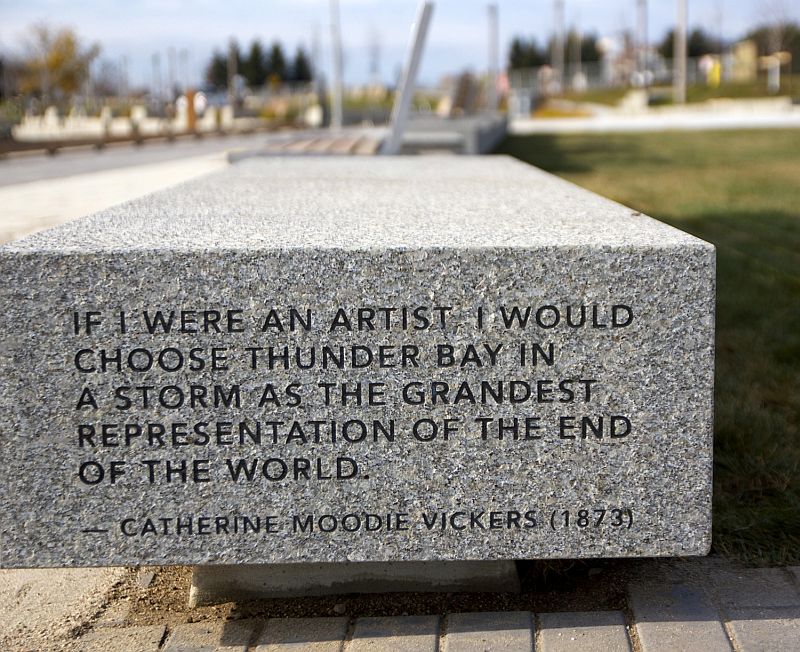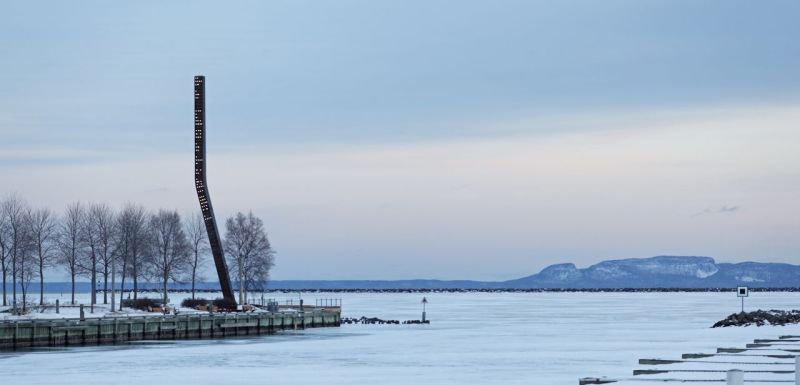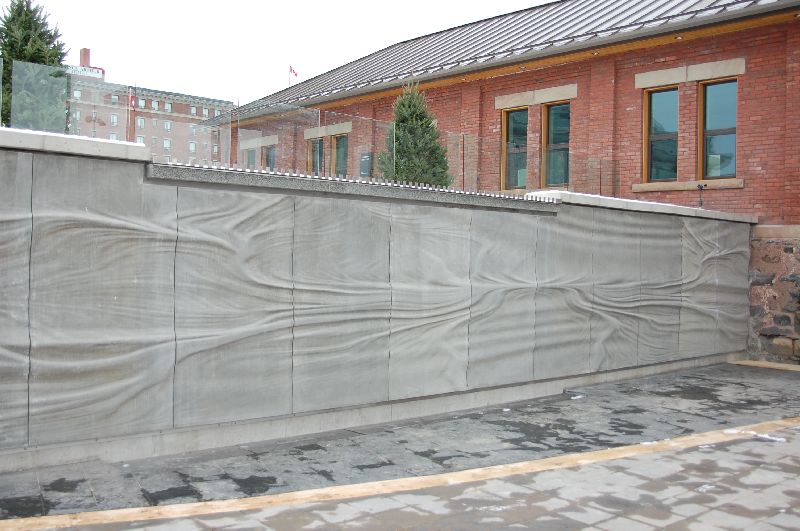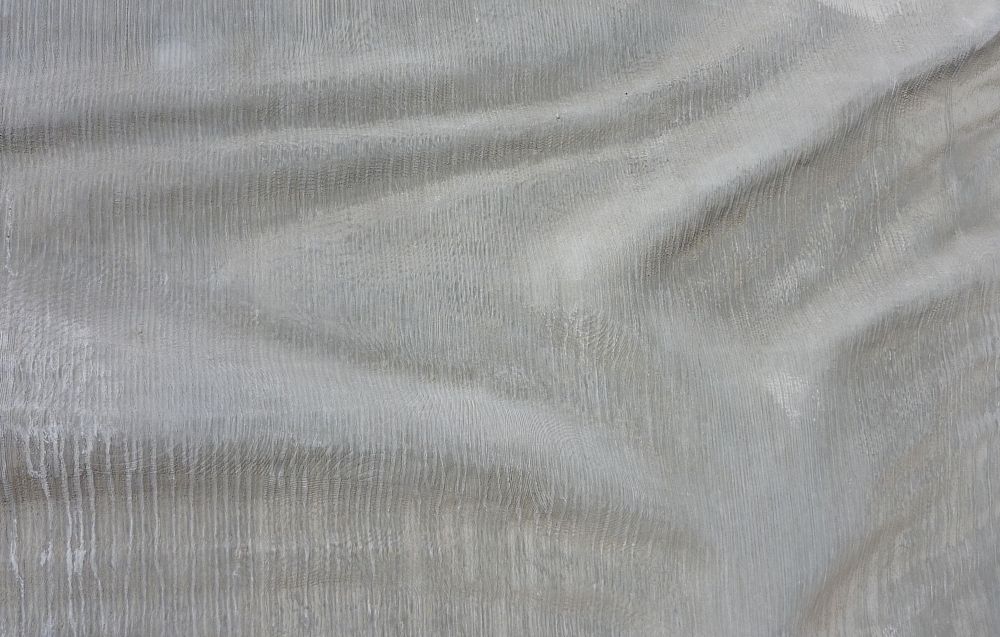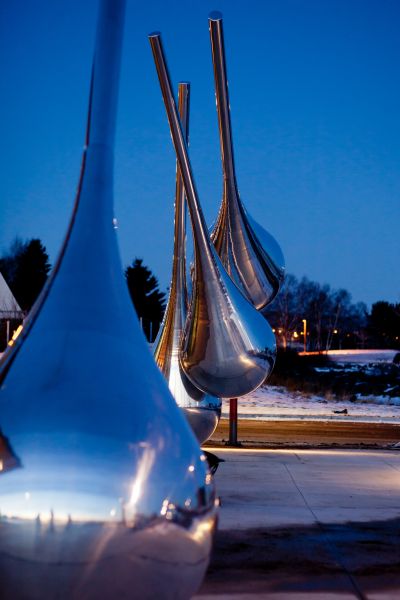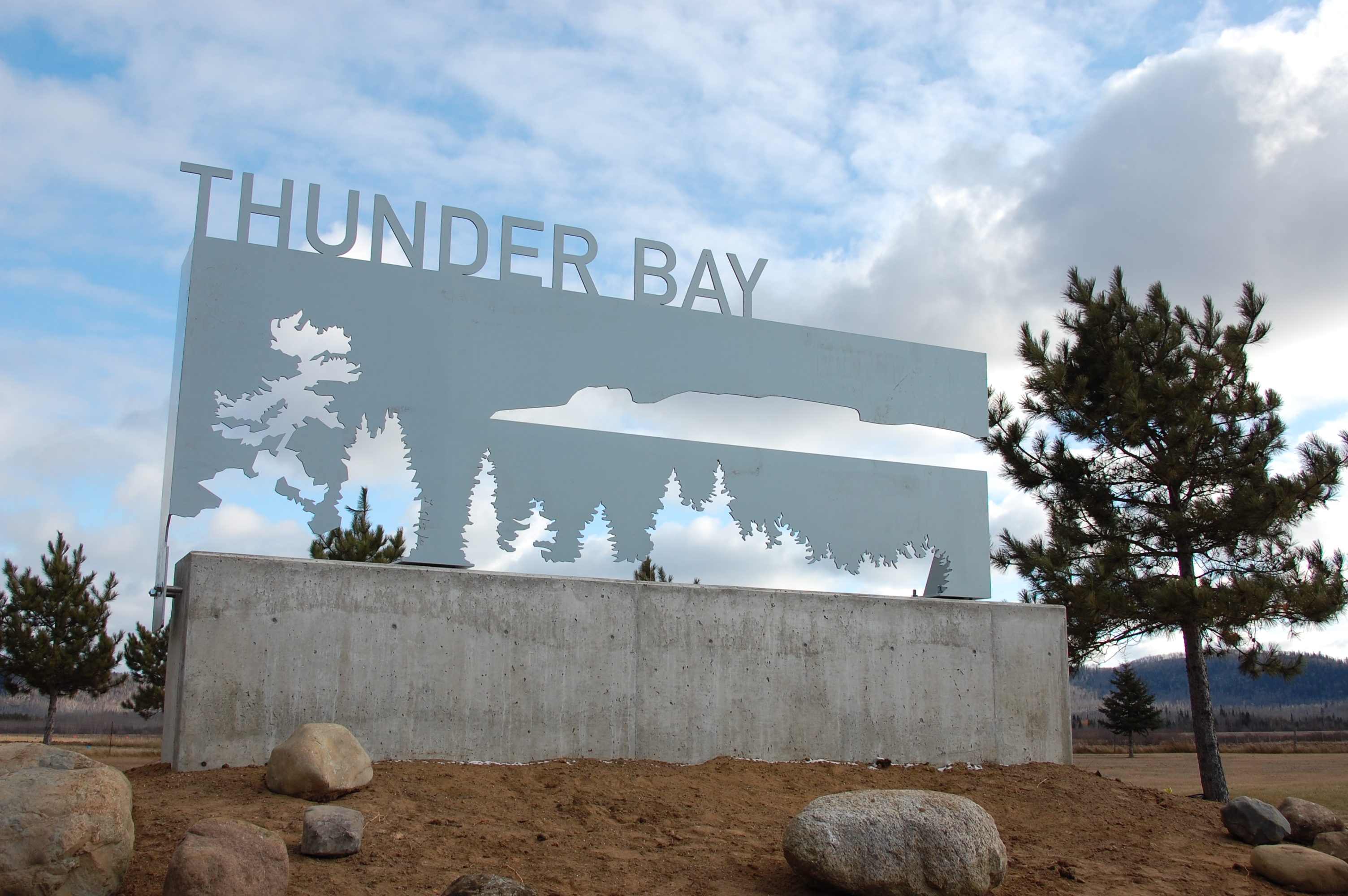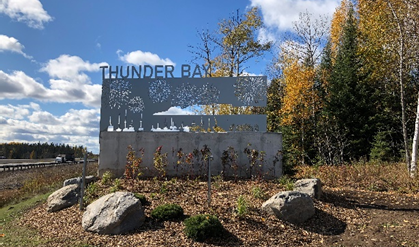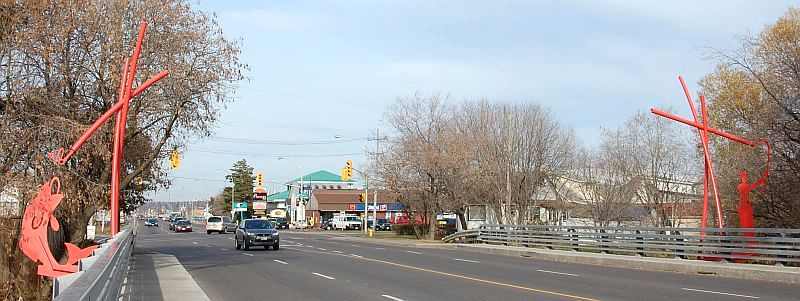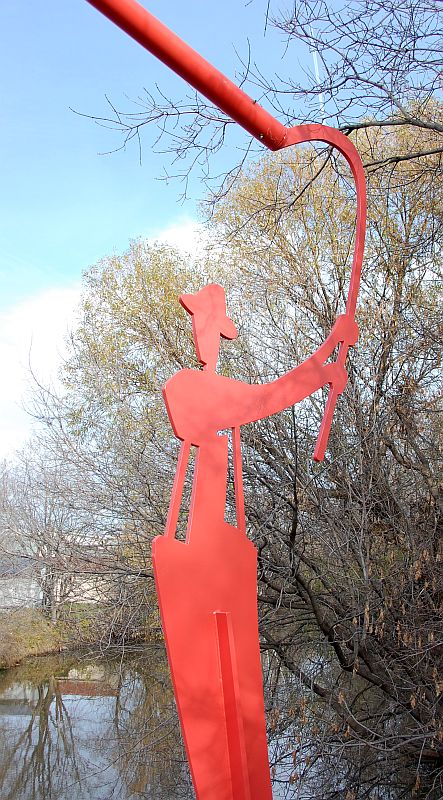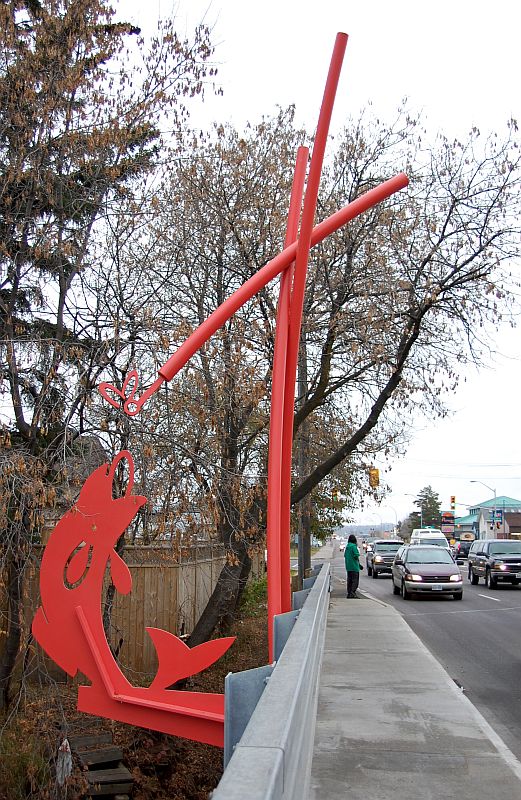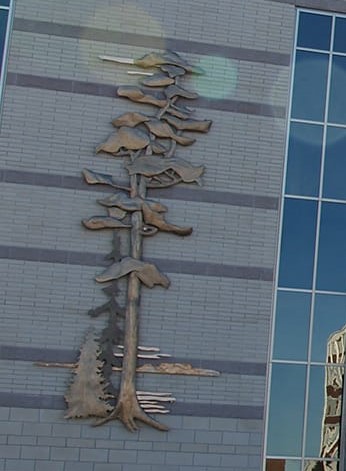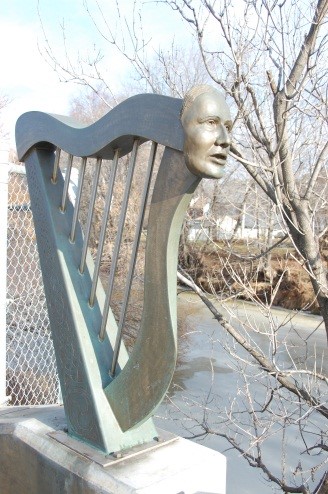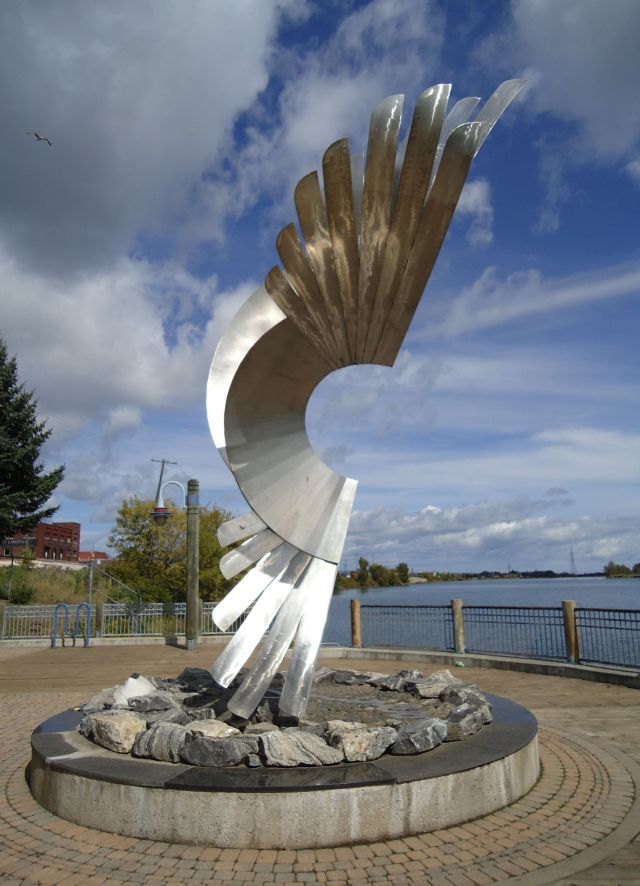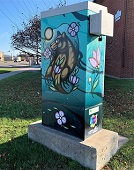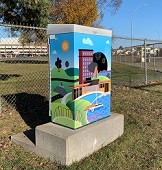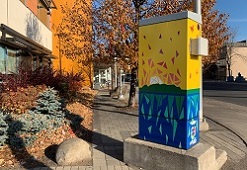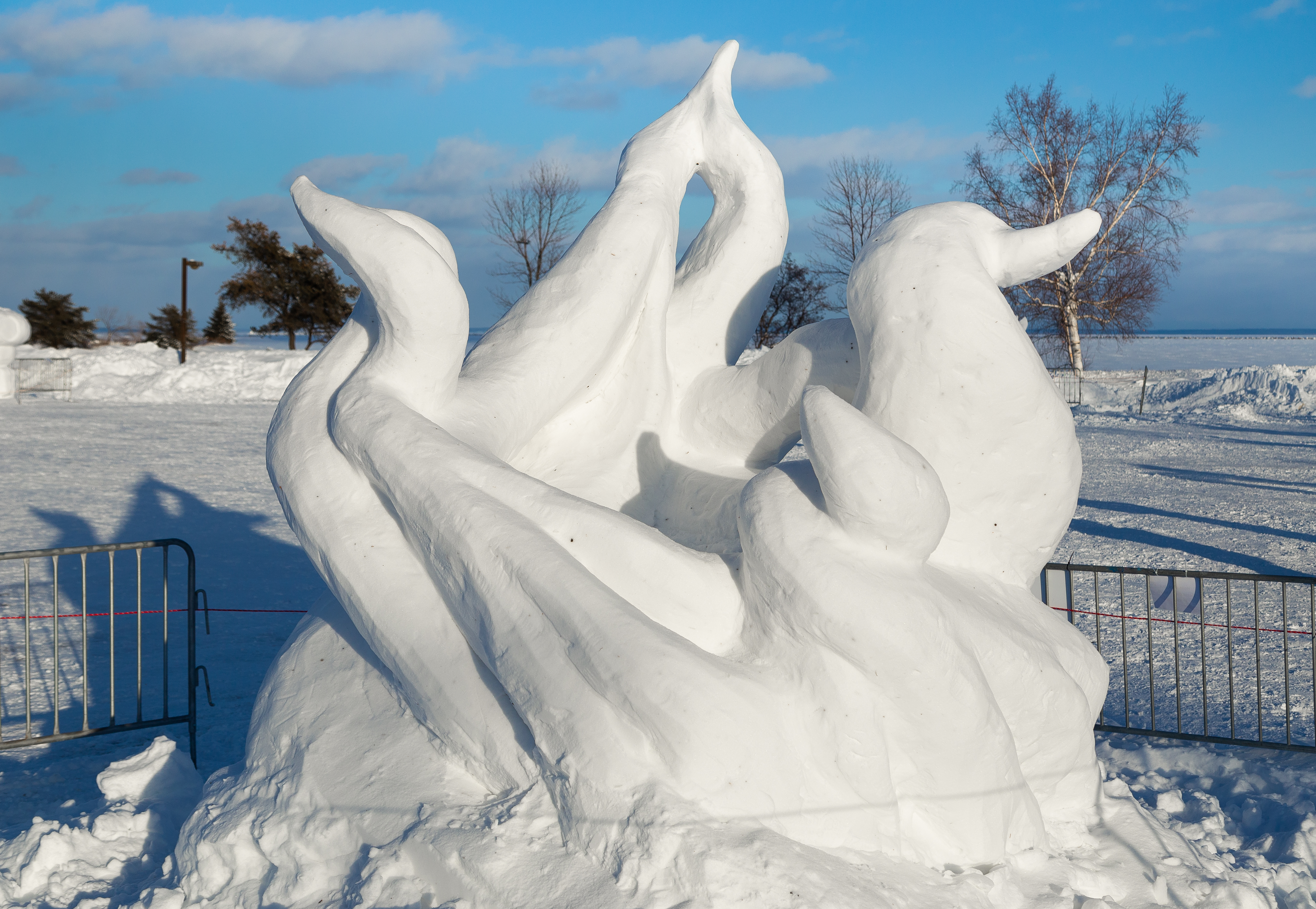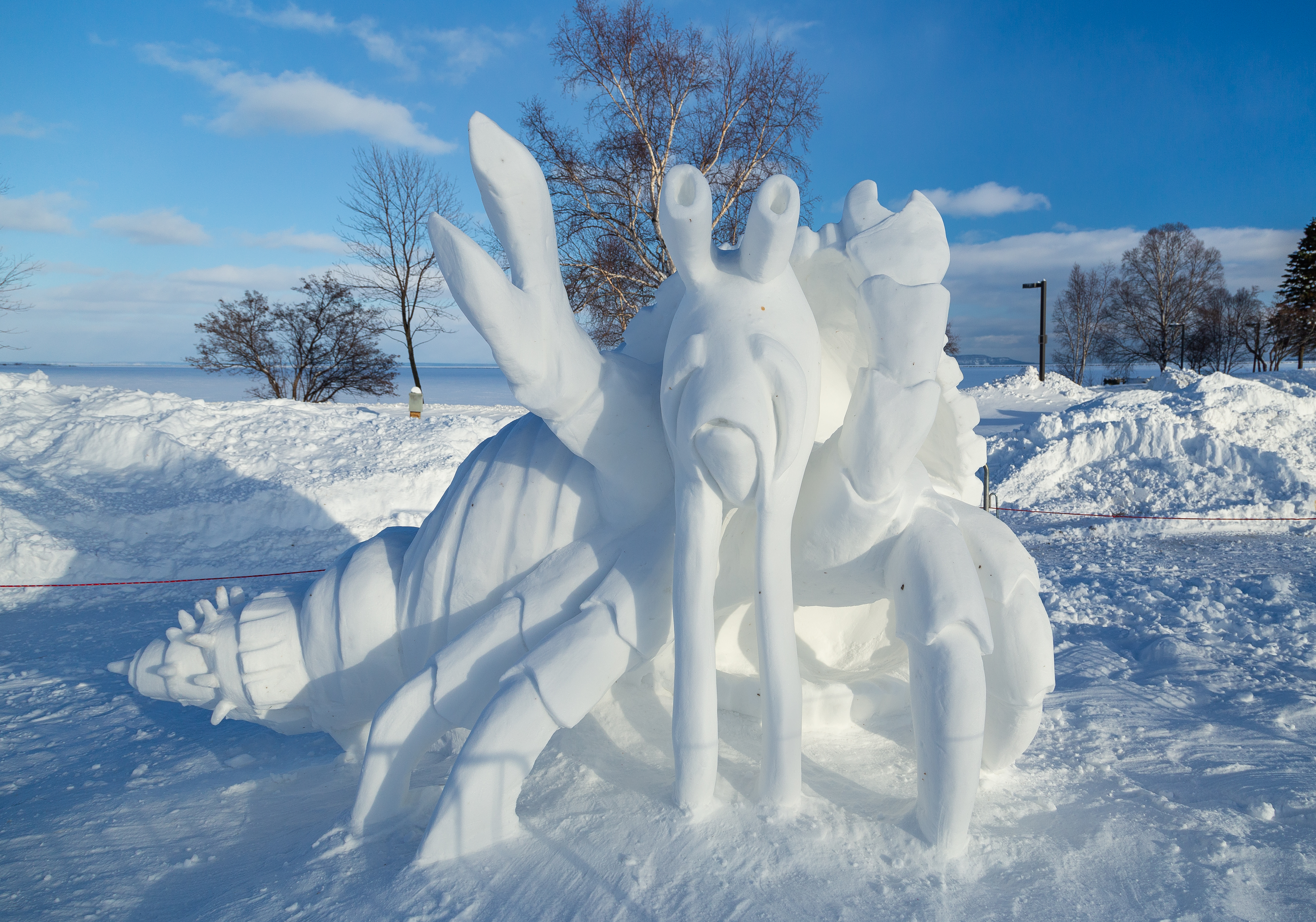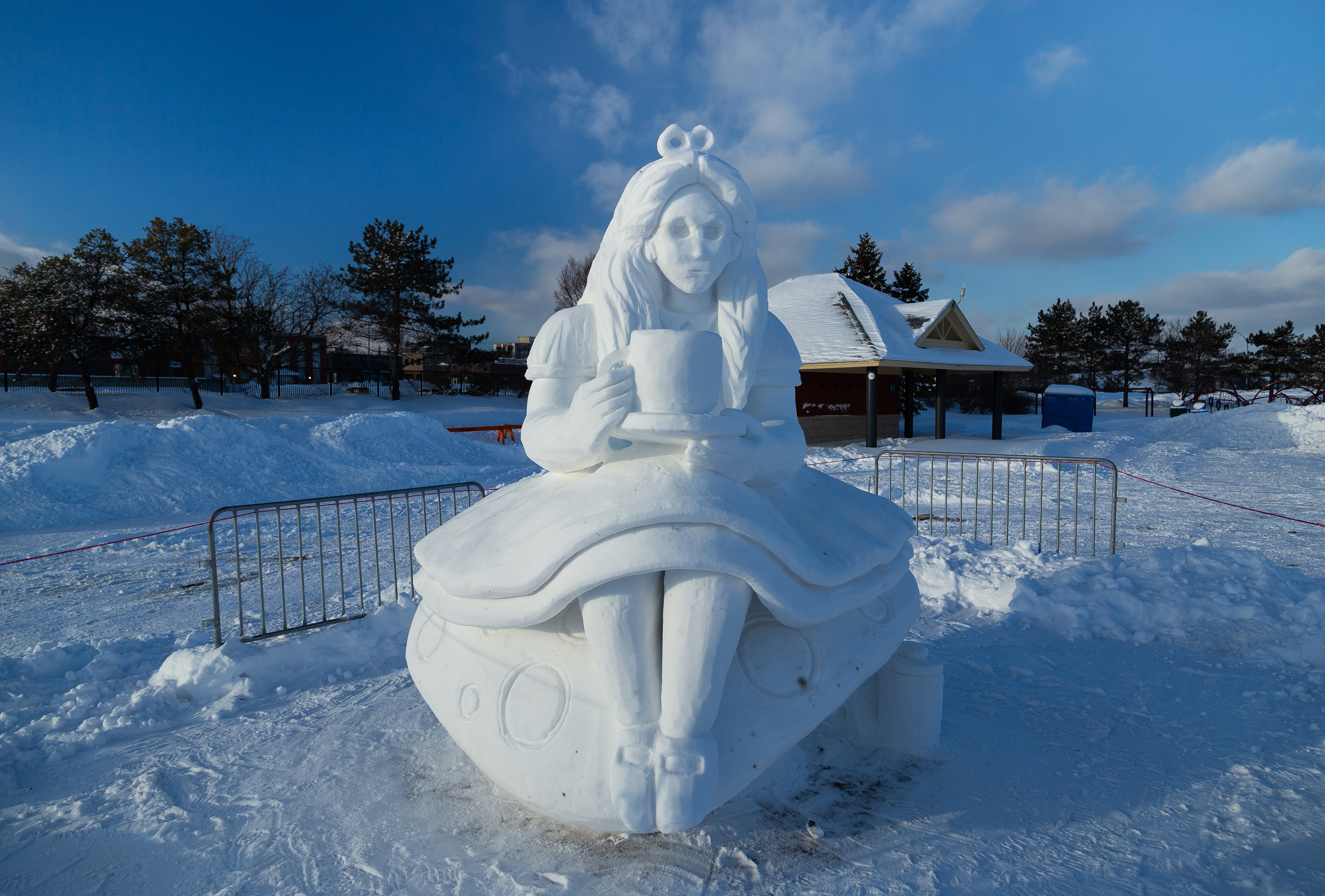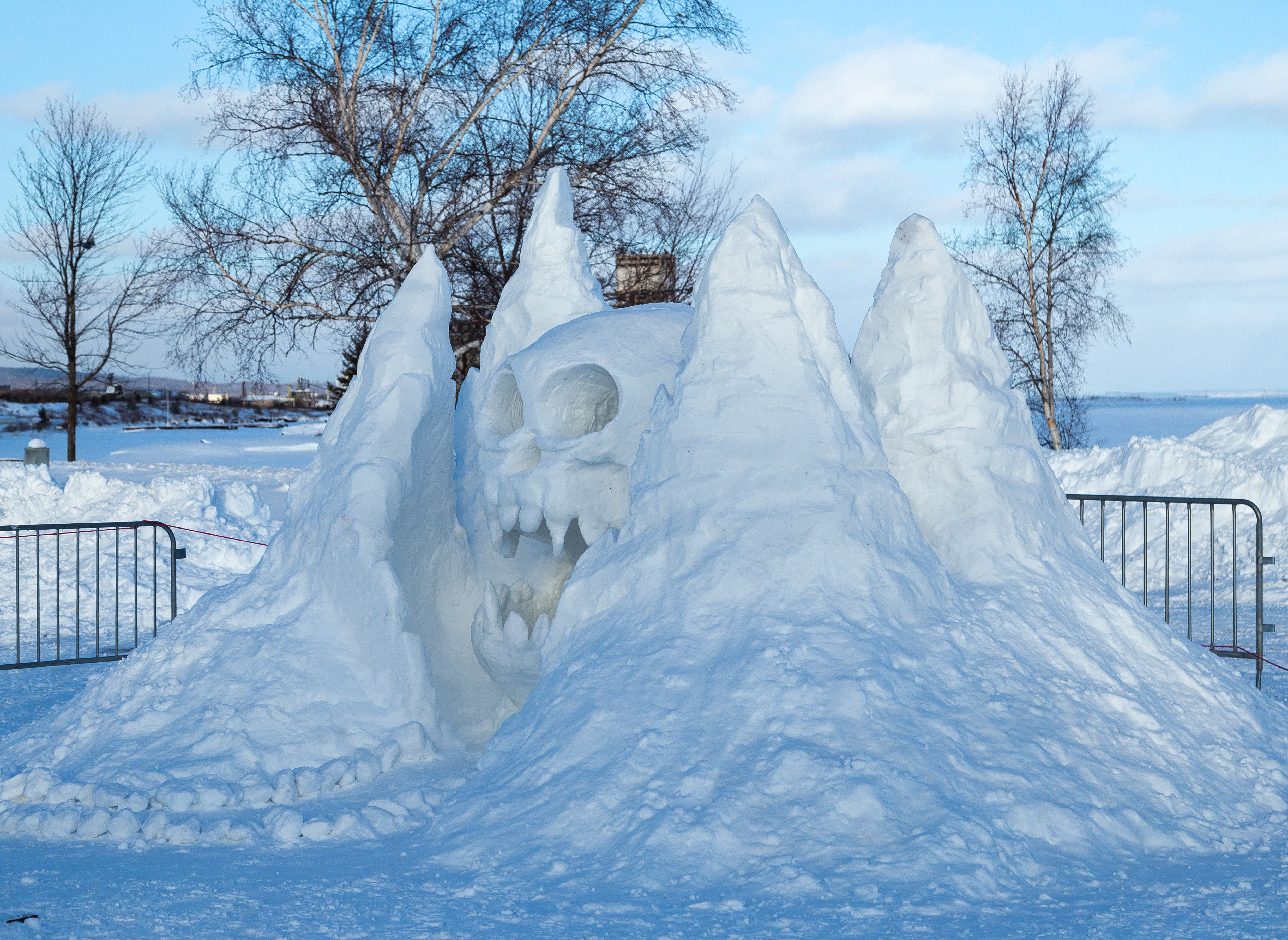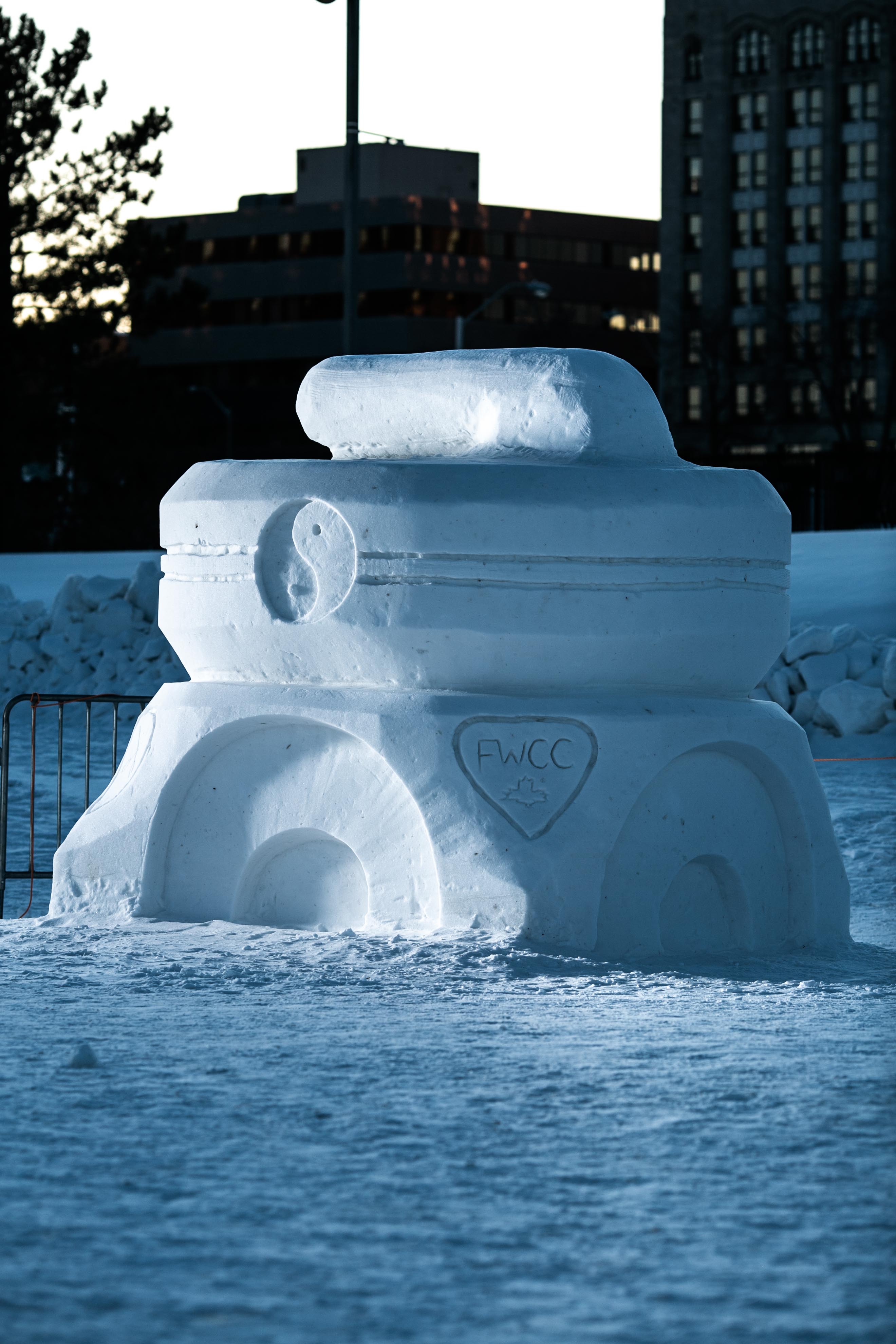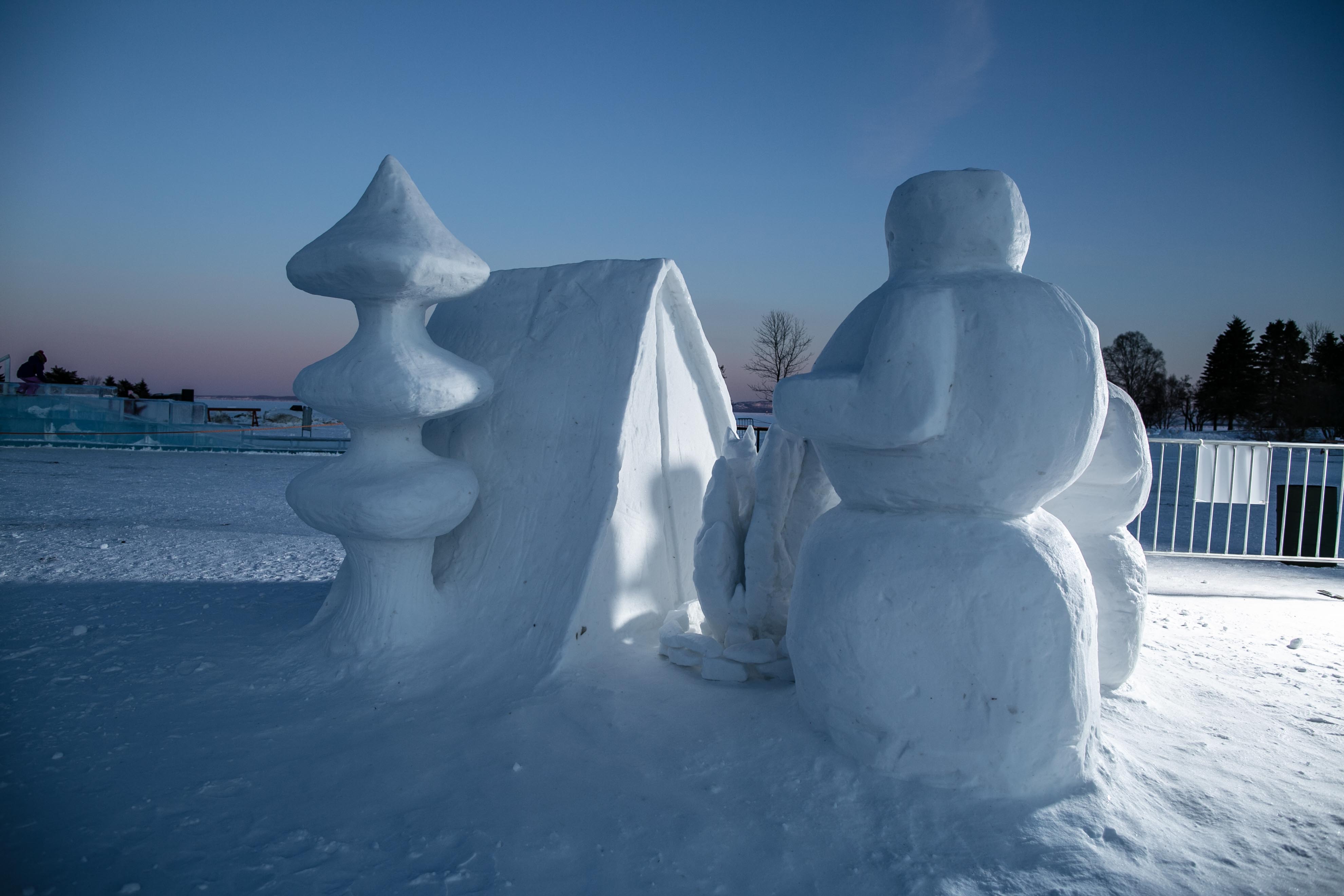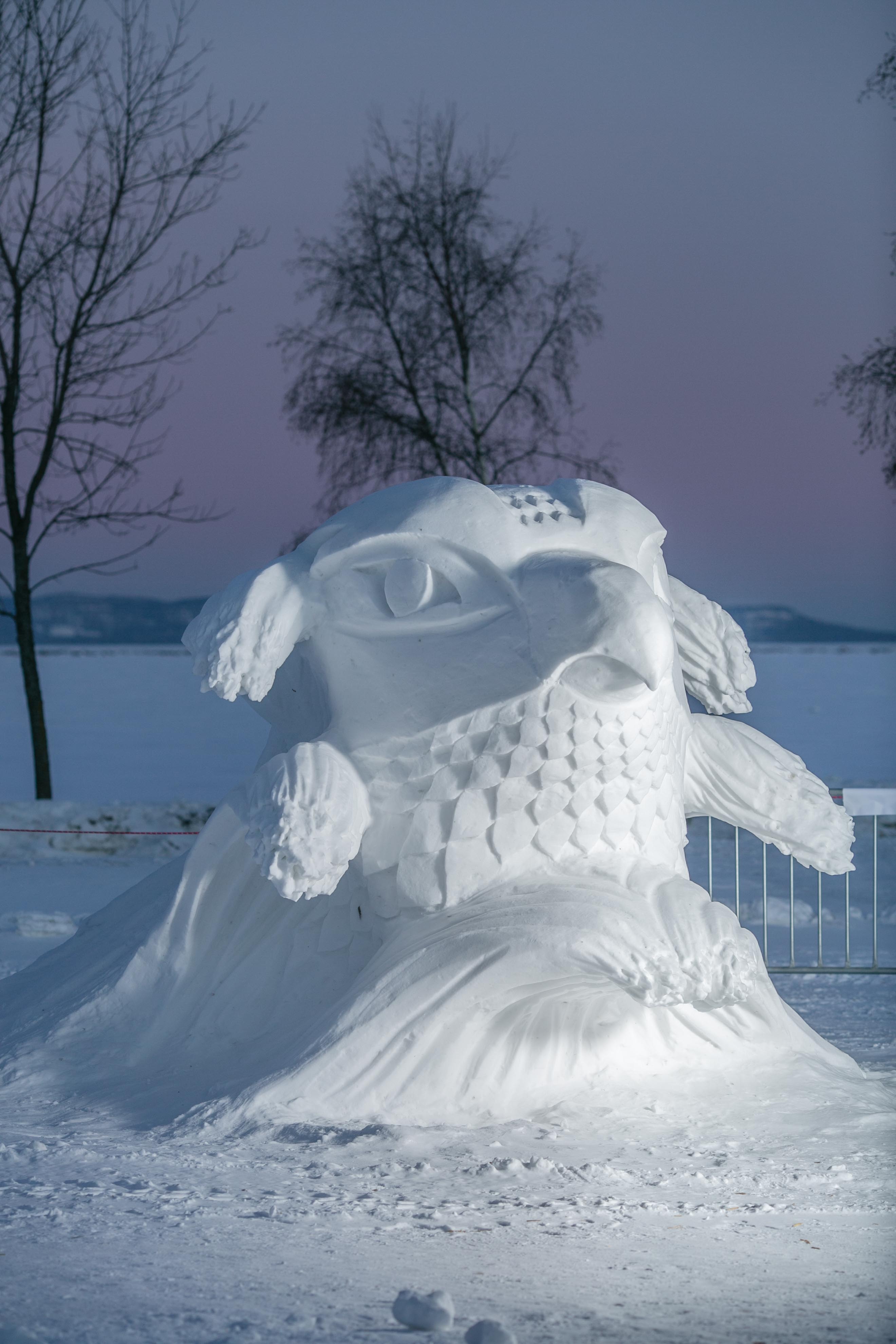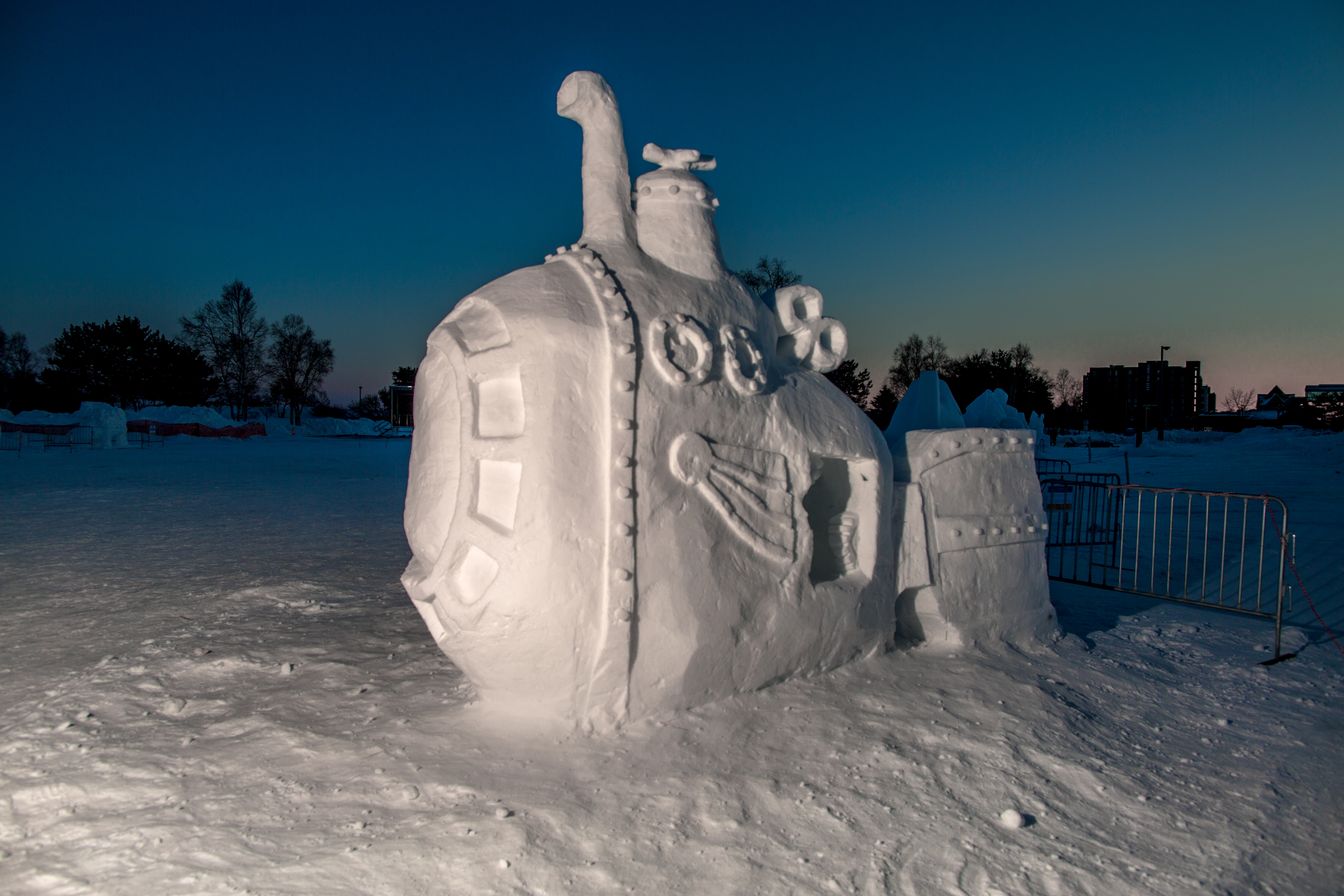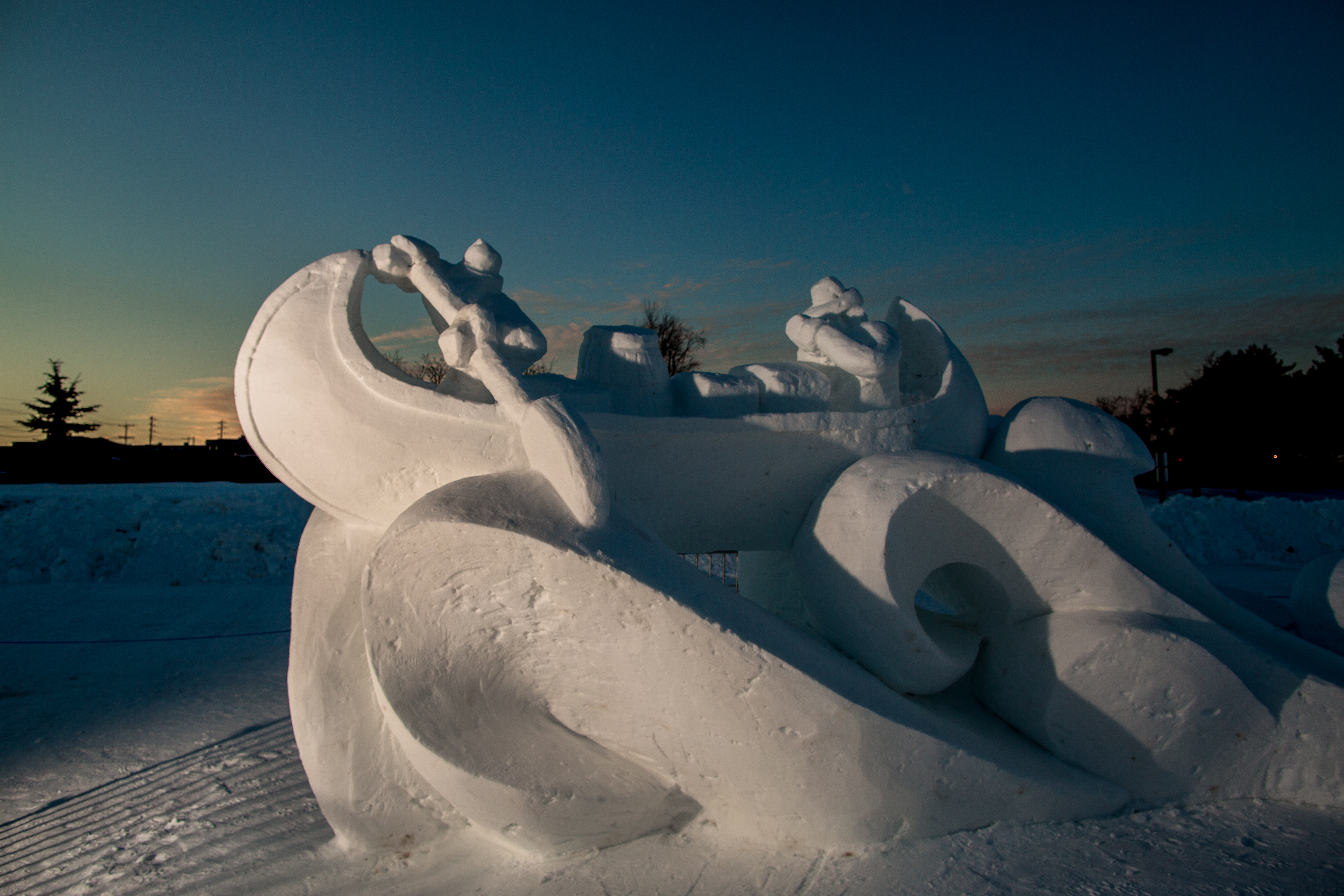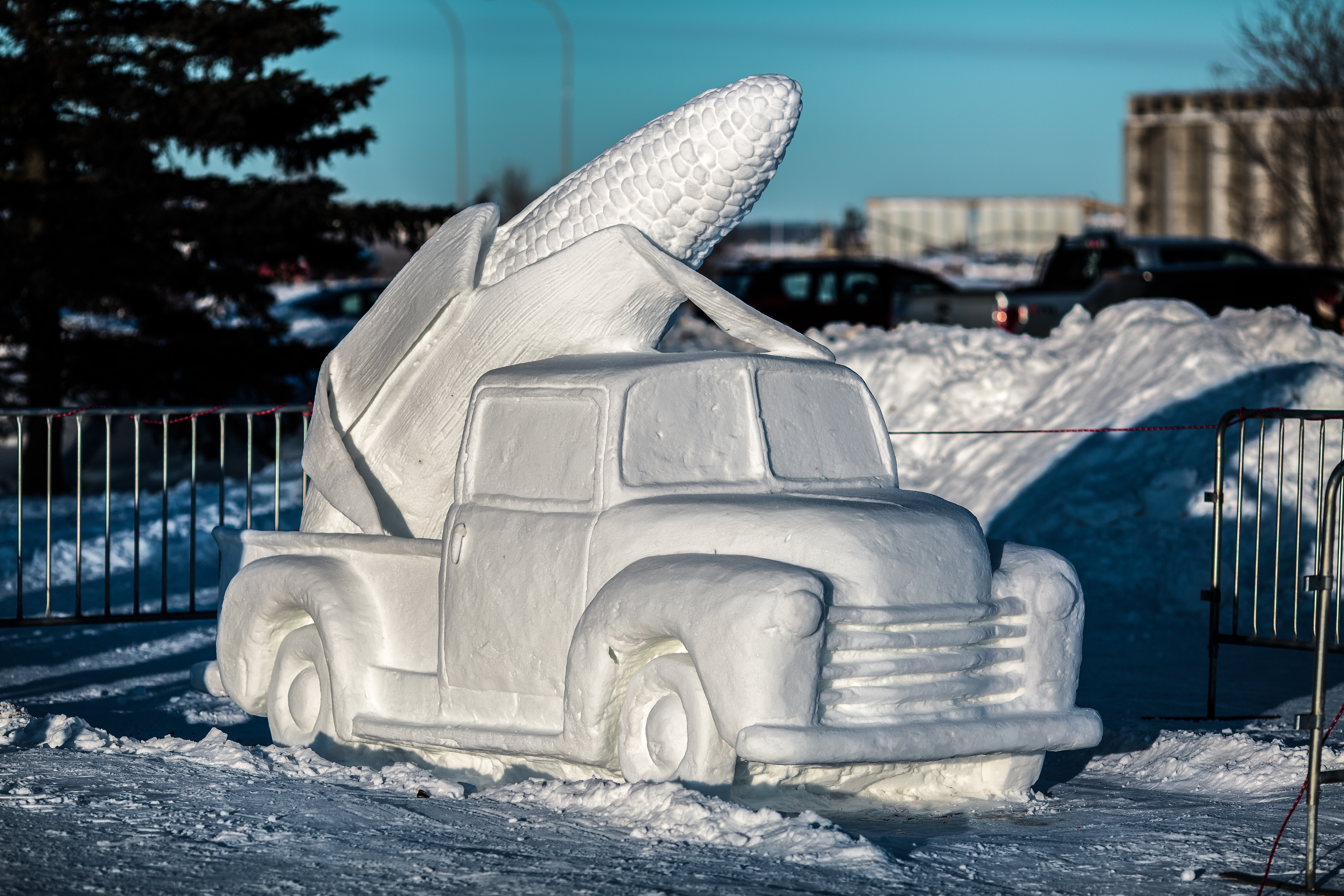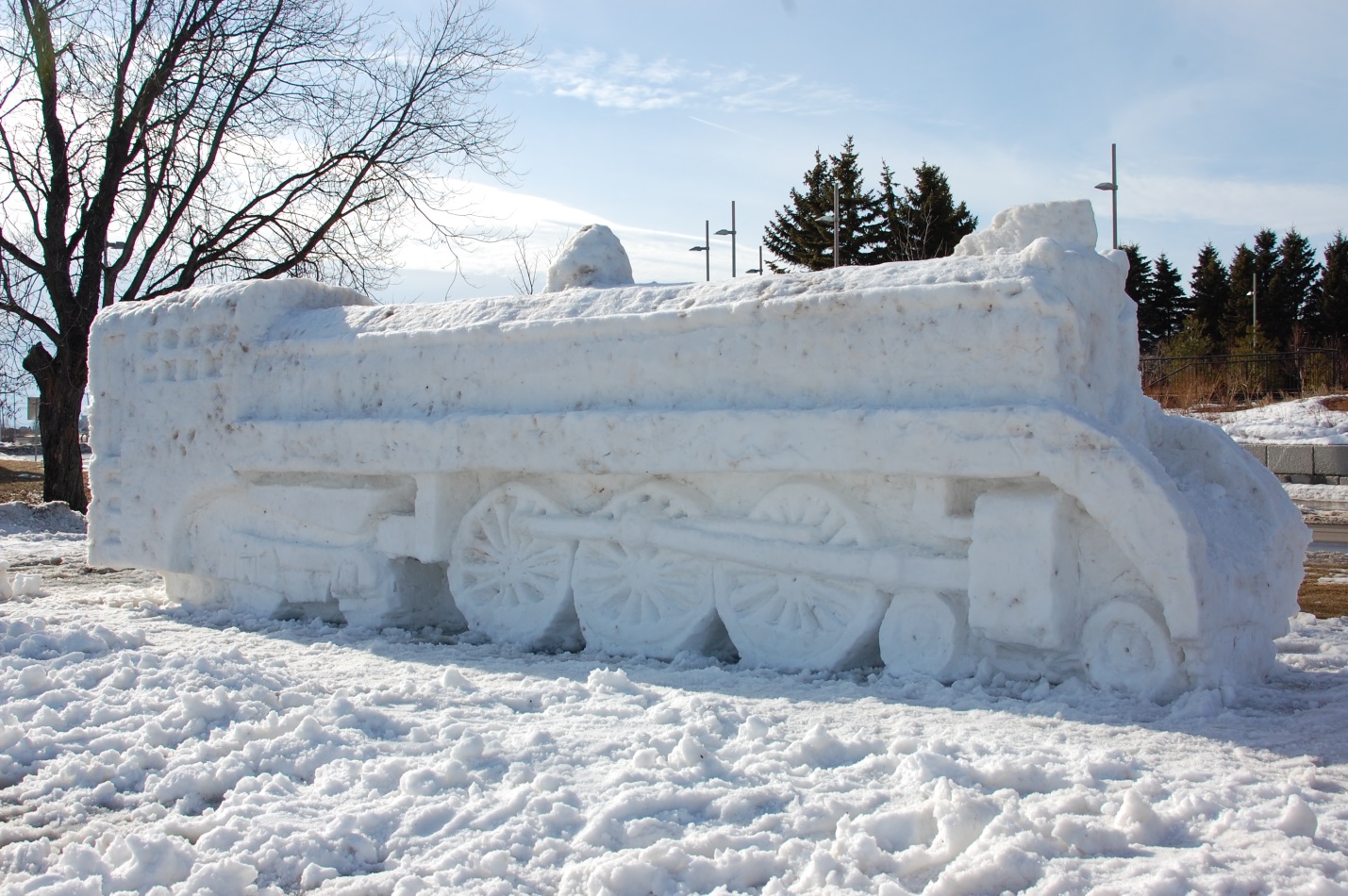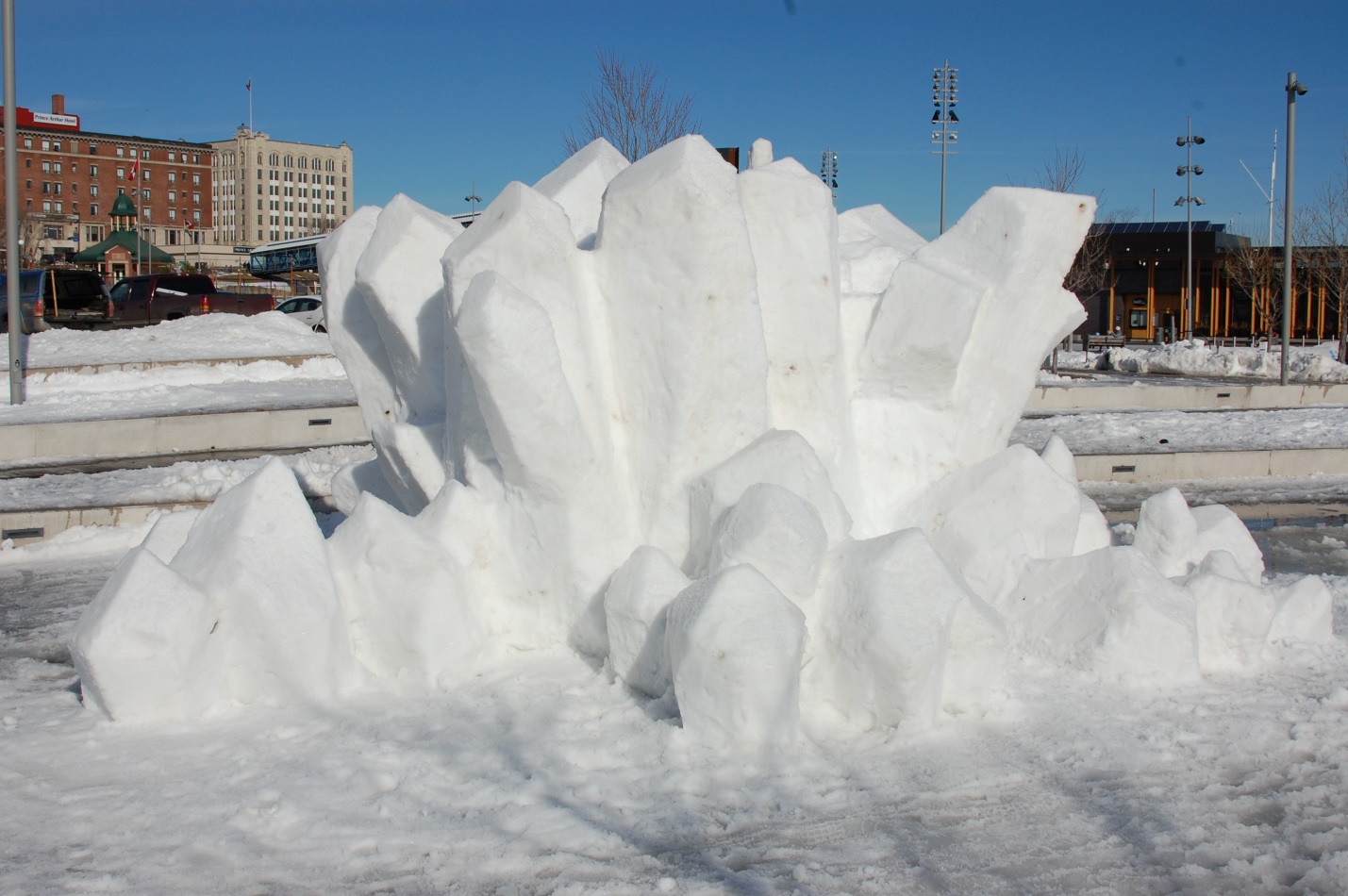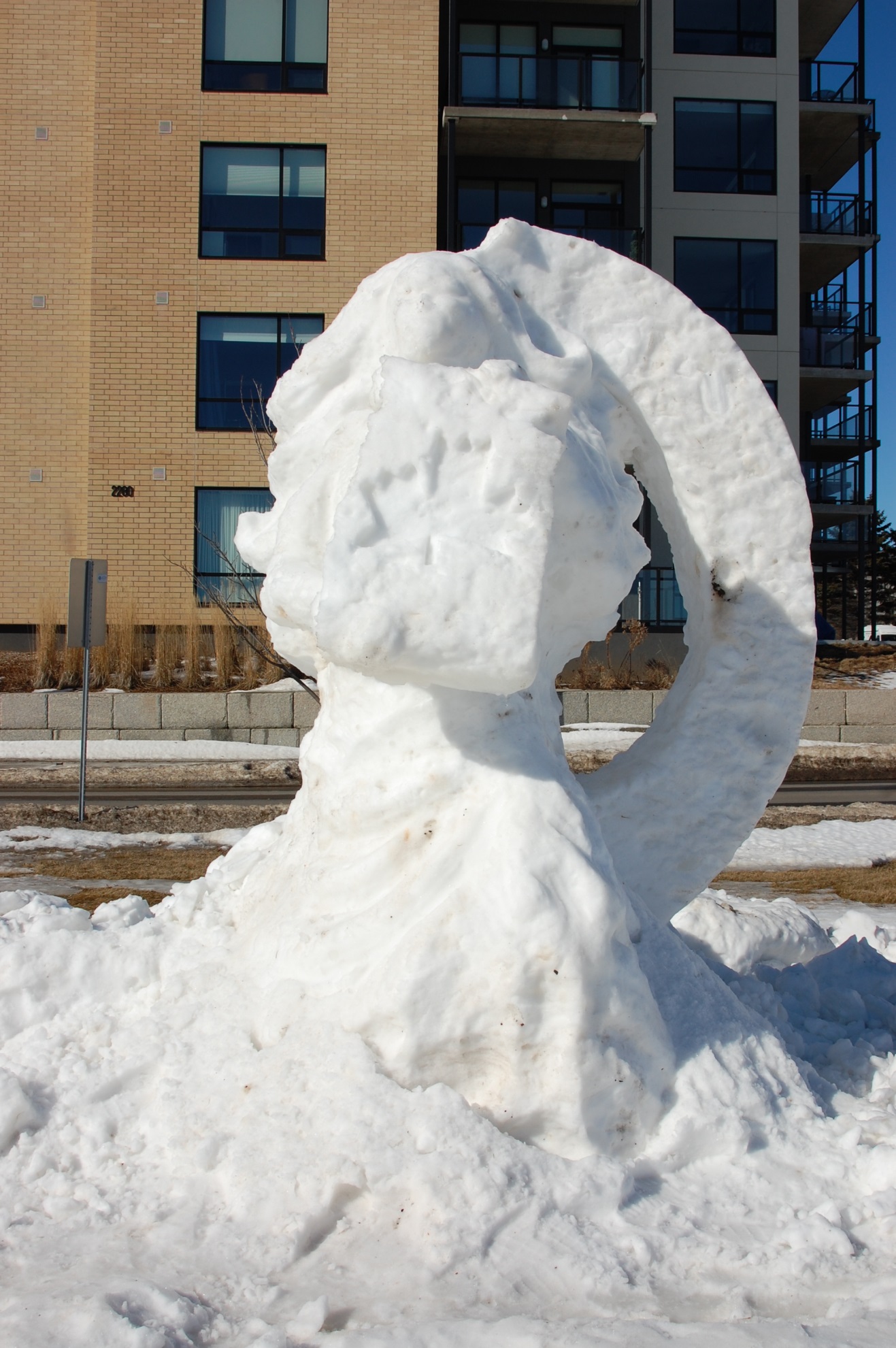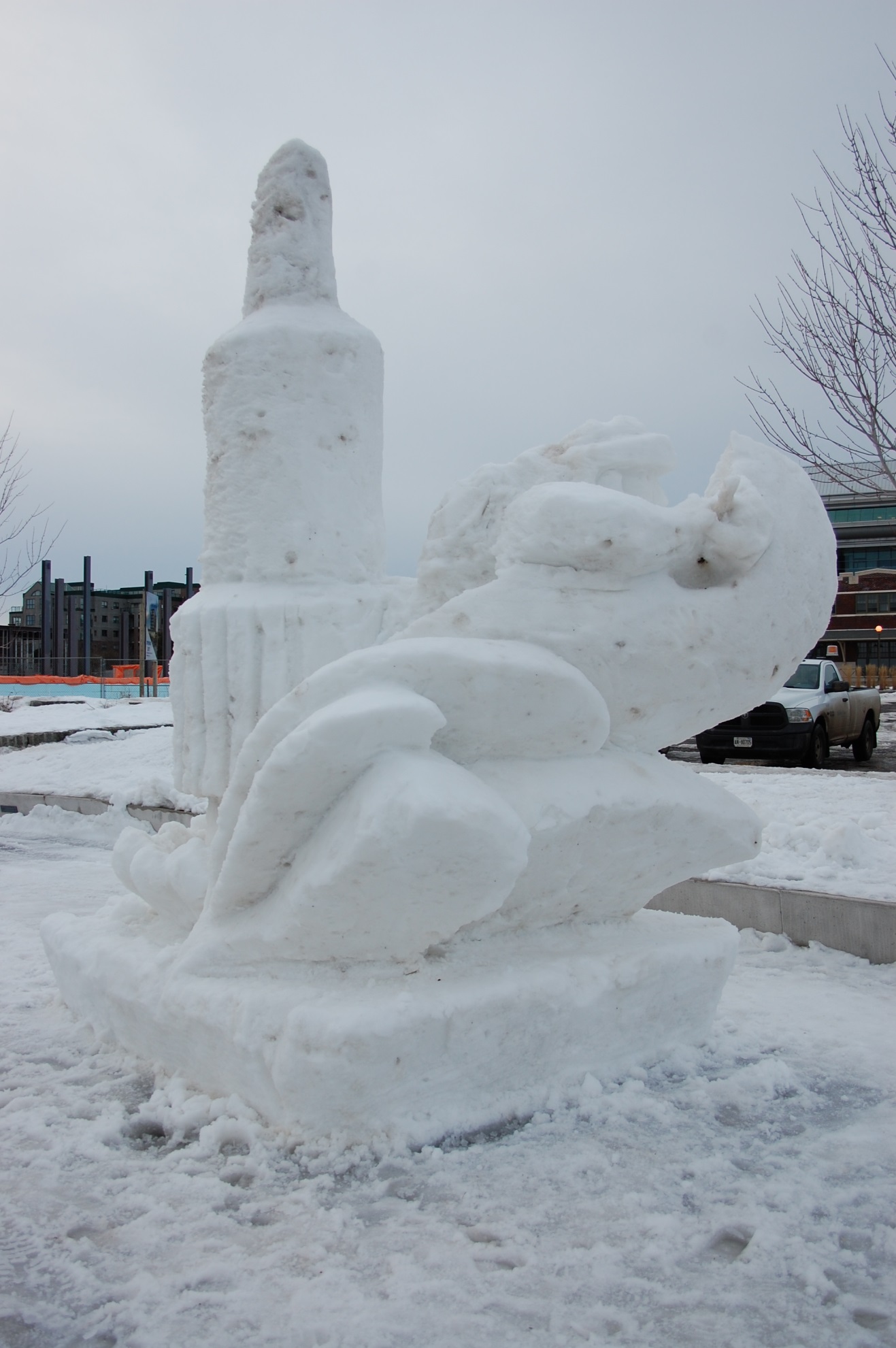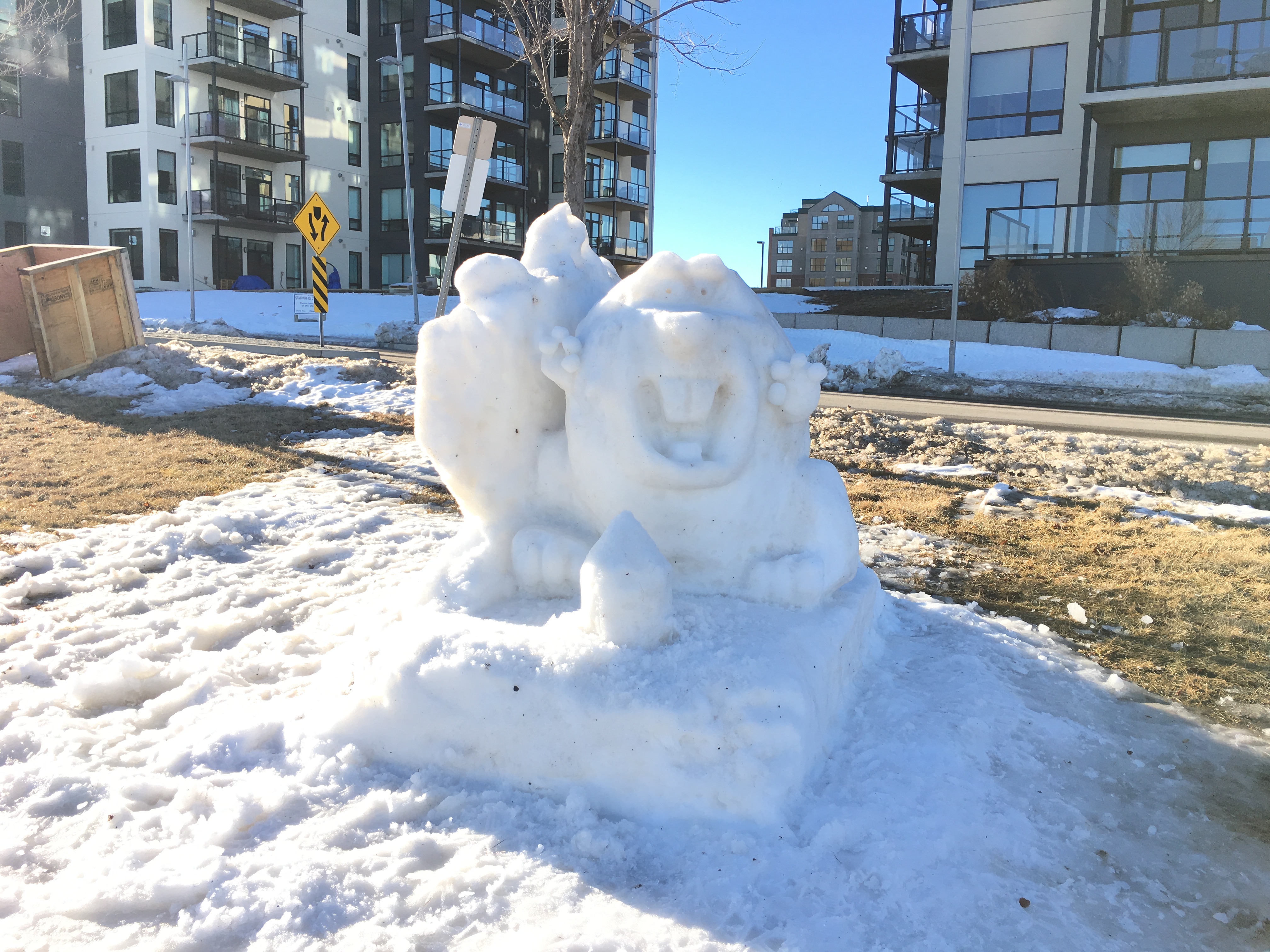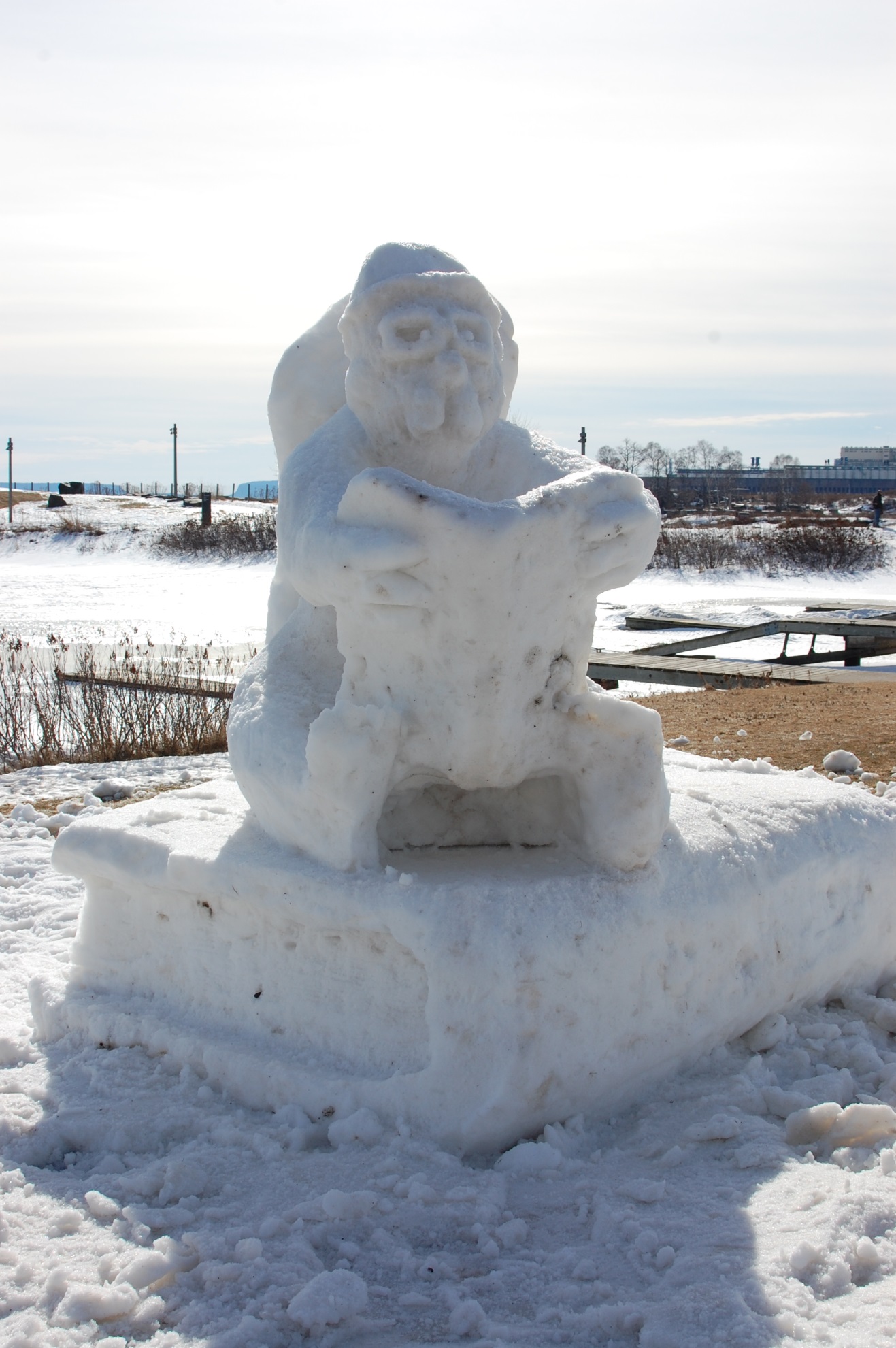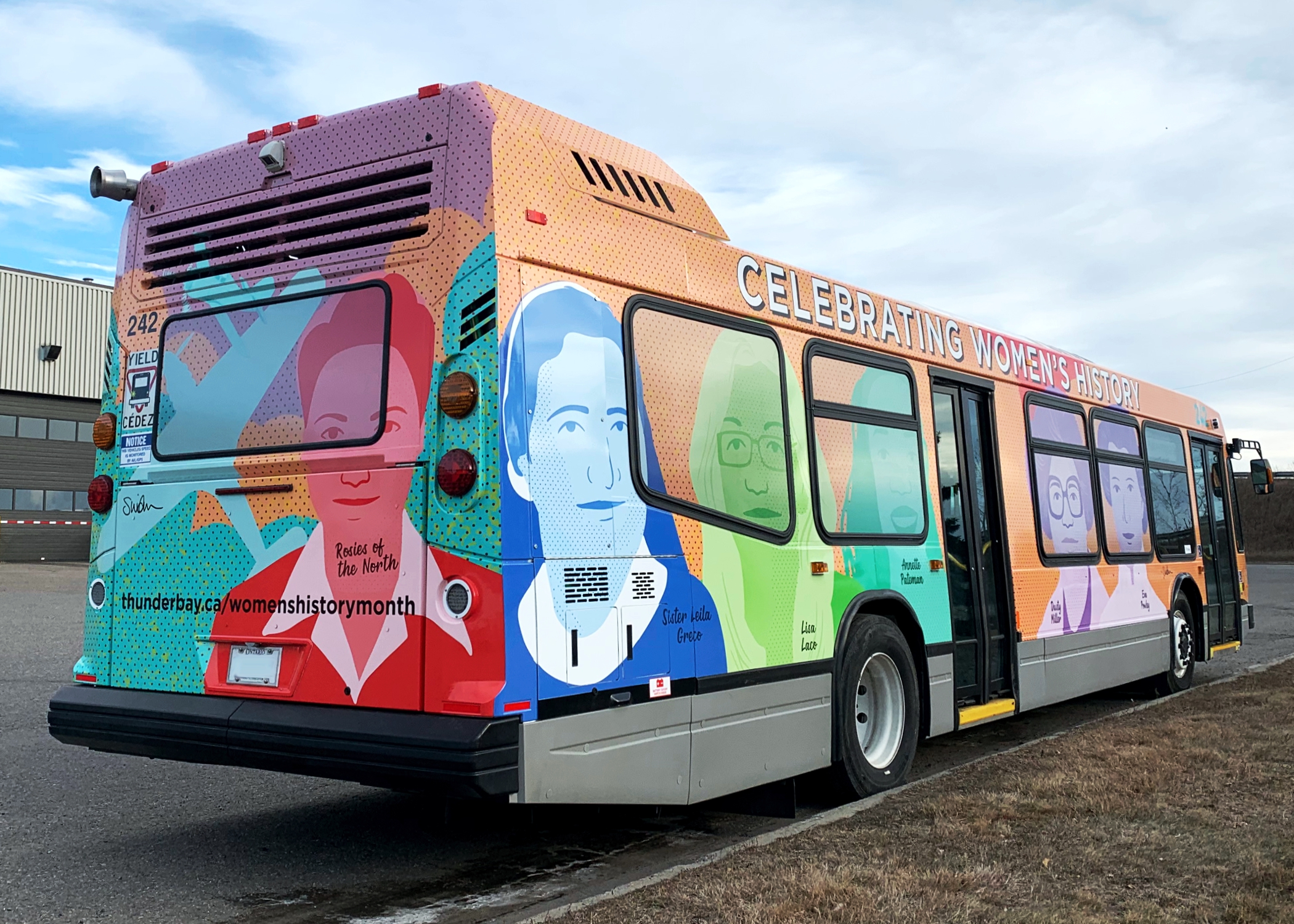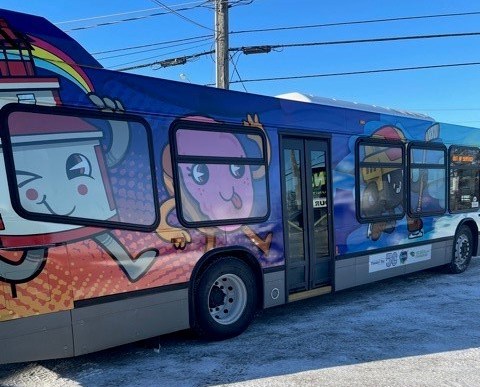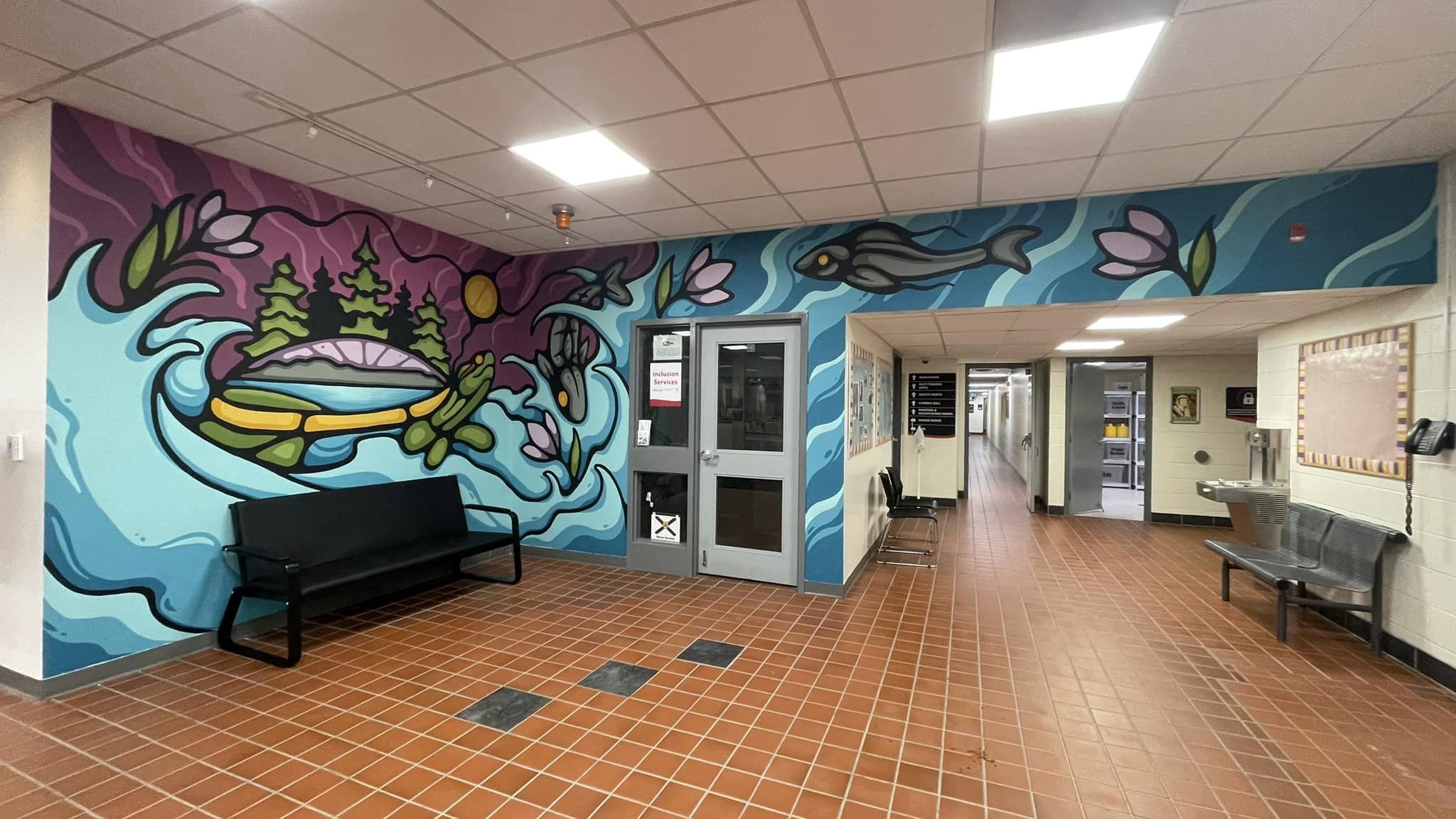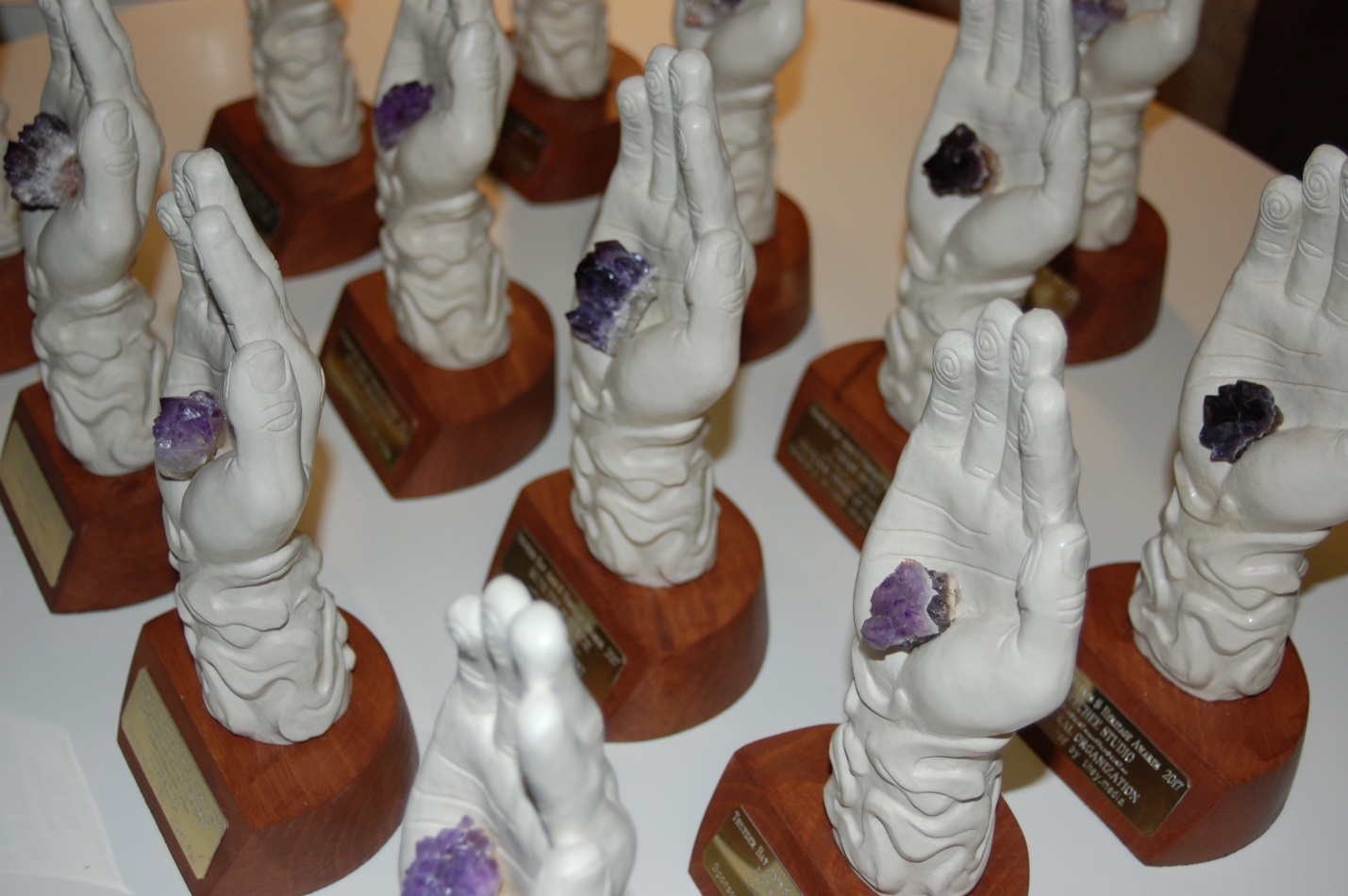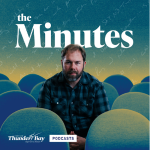Our public art collection currently numbers over 400 individual pieces. The scope of the collection ranges from large-scale outdoor sculptures to single paintings and prints. It contains items such as portraits of Mayors and officials, pictorial histories of the city and region, local landscapes, outdoor monuments and items of historical significance (e.g., The 1893 Fort William Fire and Town Bell).
The majority of the collection is on display in City-owned public spaces such as parks, facilities, office lobbies, hallways and meeting rooms. Works in storage are housed at the City Archives and Records Centre.
Guides to help you discover public art
- Check out the self guided Prince Arthur's Landing Public Art Tour - Part of The Thunder Bay Tours App
Permanent outdoor works
Wild Life - Brandon Vickerd |
||||||
|
2016
Sculptures at artist's studio pre-installation.
Wild Life is the most recent addition to the City of Thunder Bay's Public Art collection, a set of two pedestrian scale sculptures by artist Brandon Vickerd. Wild Life was installed on two curb extensions ("bumpouts") on Algoma Street South this past August as part of streetscape improvements for this section of the May-Memorial-Algoma Image Route. One sculpture is featured standing, while the other is seated on a public bench. The sculptures depict animal species native to the Thunder Bay area such as deer, black bears, squirrels, coyotes, and birds. Pre-existing taxidermy was used to create moulds for casting the bronze, resulting in the highly accurate detail of the animal figures. "Humorously referencing cartoon clichés, these sculptures invite a thoughtful reflection on our relationship to nature. Wild Life challenges viewers' perceptions by making a seemingly mundane scene extraordinary; your average loiterer in jeans and an overcoat morphing into a conglomeration of animals that is both shocking and intriguing." -Brandon Vickerd, artist
Wild Life was selected through an open competition administered by the City of Thunder Bay Public Art Program. Public input was considered in both creating the competition and making the final selection from the proposals that were received. Input was sought from attendees at events in the Bay & Algoma neighbourhood, area businesses, children participating in the City's Playgrounds Program, and comments through the City website and Facebook pages. The custom sculptures, created specifically for their new home, are the final result. The curb extension beautification project was administered by the City of Thunder Bay's Public Art Committee and Recreation & Culture Division and funded by the Clean, Green & Beautiful Committee Emerging Projects Fund. The total cost paid for the two sculptures is $112,000, which includes all aspects of the work such as artist fees, equipment, materials, insurance, structural engineering, foundations and anchoring systems, site preparation, fabrication, delivery, and installation. |
||||||
Planters and Bollards - Die Active Art Collective and Neechee Studio |
||||||
|
Sarah Mason, Lora Northway, Jean Marshall, boyRoland, Lucille Atlookan, Matilda Suganaqueb, Cynthia Edwards, Eli Castellan, Julia Di Paolo, Rill Rill 2016
In June 2016, the Recreation and Culture Division partnered with Die Active Art Collective and Neechee Studio to beautify curb extensions ("bumpouts") on Algoma Street South. Flower planters and bollards have been enhanced through street art painted by Definitely Superior's youth art collectives. Transformation of the street furnishings is part of efforts to increase visibility of the bumpouts to motorists, while infusing the neighbourhood with public art. Die Active Art Collective collaborated with Neechee Studio to create paintings that reference the area's Finnish and Oji-Cree heritage. The two cultures are represented through a fusion of beadwork motifs and traditional Finnish textile patterning. Artwork on two planters depict a water theme, while the other two represent a land theme, all incorporating representations of animals common to Finland and Canada. This project was administered by the Recreation and Culture Division with funding from the City's Clean, Green and Beautiful Committee. Beautification of Algoma Street South aligns with goals of the City's May/Memorial/Algoma Image Route, part of the Urban Design Guidelines. The addition of artwork to the otherwise standard curb extensions fulfills one the goals of the Public Art Committee, which is to integrate art into daily life. |
||||||
Community - Calen Banning |
||||||
|
2015
A design competition was administered to select artwork that would communicate the goals and services of the Recreation & Culture Division. The design would be printed onto adhesive-backed vinyl and applied onto 5 window panes of the divisional offices. Community, the design created by Thunder Bay artist Callen Banning, depicts a variety of people of all ages benefitting from the services provided by the City. Arts and culture, children and youth programs, events, community centres, recreational programs, and older adult programs are represented. The offices of the Recreation & Culture Division are located within Victoriaville Mall and face a hallway frequented by members of the public. The art competition was an opportunity to showcase local artwork and support the integration of art in daily life while providing a functional privacy screen for City staff. Project funding was provided by the Recreation & Culture Division.
|
||||||
Pulse - Scott McKay |
||||||
|
2012
Pulse, by artist Scott McKay, is located in front of the Superior North Medical Emergency Services (EMS) headquarters facility and was selected by a jury through an open competition administered by the Recreation & Culture Division. The shape of the sculpture references the lines of a heart rate monitor, known as the QRS Complex. The artist has considered how the simplicity of this line is a representation of human life. The business of life saving and preservation is a noble one and the honour of creating a piece of art which will symbolize this is inspiring. The QRS wave, is the essence of ourselves in terms of medical simplicity. As with the heart rate monitor the pulse moves from left to right. Three beats in total with increasing strength to the right side. Time is defined by the progression from left to right. The importance of service is represented by the increasing strength of the beat. The stainless steel embodies the endurance and timeless effort provided by Superior North EMS.
Construction of the EMS building completed in 2012, and the incorporation of artwork is part of the City's Clean, Green and Beautiful policy, which specifies that a percentage of the City's gross capital budget for new infrastructure is allocated towards Clean, Green and Beautiful initiatives such as public art. |
||||||
Bike Rack Panels |
||||||
Four selected artists:Carole Kajorinne - Fate Luke Nicol - Pine Jean Marshall - Plantlife Jennifer Nichols - Memory Wheels Turning 2012
In 2012 the Recreation & Culture Division collaborated with Active Transportation Thunder Bay to incorporate local artwork with new bike racks. The resulting Bike Racks for Business program, funded by the City's Clean, Green and Beautiful Committee and launched in June 2012, provides local businesses and organizations with consistent, effective bike parking, as well as a means for artists to showcase their designs throughout the city. The addition of artwork to the otherwise standard U-shaped racks fulfills one the goals of the Public Art Committee, which is to integrate art into daily life. The four winning designs were selected by an open competition process and assigned to particular parts of the City based on the location of the Image Routes, which are part of the Urban Design Guidelines currently in development. Plantlife is part of the Red River Road Image Route, Pine is part of the Arthur Street Image Route, and Fate is part of the May/Memorial/Algoma Image Route. Memory Wheels Turning is installed at locations elsewhere in the City, such as Westfort and Water Street.
|
||||||
Written Art Installations - Literary Selections |
||||||
As part of the Prince Arthur's Landing public art plan, various literary selections have been incorporated into the park, creating opportunities for moments of reflection along the shoreline. These modern and historical selections were written by local and regional authors, or by individuals who once lived and travelled to the area. Some of the pieces were selected through open competition and others were researched and selected by the Waterfront Development Design Team after consultation with the local writing community. The literary selections, along with the park's cultural and interpretive signs, together embody the spirit, history, geography, and culture of the land of Northwestern Ontario. They give expression to the significance of the site: Thousands of years of aboriginal settlement history, the western threshold of the largest freshwater "sea" in the world, the junction between the western railways and ships of the Great Lakes, and the place where western and northwestern Canadian troops bid farewell as they headed off to WWI and WII. Works by:
|
||||||
Jiigew - spmb (Karen Shanski & Eduardo Aquino) |
||||||
|
(In collaboration with Brook McIlroy Architects) 2011
"Jiigew are two sculptures inspired by shipbuilding that mark the waterfront landscape, giving a sense of place for those who approach the waterfront from the city and from the lake. At dusk the light pixels gently drop down the length of the sculpture like a waterfall, communicating by way of Morse code. Sound accompanies the lights, broadcasting a narration by Pat Ningewance and Rick Smith. Together the light pixels and the sound recount the mythologies, histories, and poetry around the theme of "water" that help to form the collective consciousness of Thunder Bay". -Eduardo Aquino & Karen Shanski, spmb (artists) Jiigew, Ojibwe for "by the water," is the City's first public art project with an exclusive focus on digital media, light and sound. The award-winning design for the two structures was achieved through a collaboration between the artist team spmb, and Brook McIlroy Architects.
'The Beacons' as they have become known, are built from corten steel and house the lighting and narrative developed by the artists. The illumination comes into effect after dusk. Jiigew are destination points at the end of Piers 1 and 3. They are strongly connected and visible to the community by land, air and water. A fusion of art and architecture, the Beacons are iconic, signature pieces on the city's waterfront. "The design concept has carefully considered the idea of "duality" as a major conceptual direction for the project. We considered duality not as opposites but as complementary parts of a whole, understanding the Beacons as part of one same cityscape: the shoreline, the lake, and the landscape beyond. The quality or state of "being dual" or of "having a dual nature" evokes the Ojibway mythology, and serves to the many formative features of the project's context and the City of Thunder Bay's history. Some of these dualities are: land/sea; earth/sky; Port Arthur/Fort William; day/night; summer/winter; sun/moon; sleeping/awake; myth/reality, etc. In this way we do not see a separation between the art (light/sound) and the architecture (the beacon's structure) but recognize the full integration of the two as a major force of this project, producing a poetic synthesis on the Thunder Bay coastline". -Eduardo Aquino & Karen Shanski, spmb (artists)
|
||||||
Celebration Circle Panels - Randy Thomas with Roy Thomas |
||||||
|
2011
"I am an Ahnisnabae born artist. I use my spirituality and inspirations around me to paint.The series of images I created are of the Woodland style, created in this region of Northern Ontario by our ancestors of long ago. The images show the animals that represent the air, land, water and fire. The turtle image from the Ahnisnabae culture represents this land; North America. The Thunderbirds represent great power. I strongly believe in keeping tradition and to never forget where you come from. Through my art I thank my ancestors and relatives for passing on their teachings". - Randy Thomas (artist)
The exterior face of the Celebration Circle features artwork by Randy Thomas on nine corten steel panels of varying size. The Celebration Circle was designed by architect Ryan Gorrie originally from Thunder Bay, and is part of the Spirit Garden, a place where local Aboriginal artistry, culture and traditions are reflected and celebrated. Thomas is one of the City's emerging young artists and his interpretation of the competition theme, placed emphasis on sharing, peaceful co-existence and regard for the natural world. Thomas's mentor, the late Roy Thomas, is recognized internationally for his skill and distinctive style of Woodland art. To honour his father, Randy chose to include Roy's work Lifegivers amongst the panels.
Panel 1: The Great Thunder - "Great thunder is the greatest power of all." Panel 2: Keeping Tradition - "Fire is a life element, it is natural to gather around a fire." Panel 3: People of Turtle Island - "All walks of life live on Turtle Island together." Panel 4: Turtle Island - "Wolf is the land, bird is the air, fish is the water on Turtle Island." Panel 5: Lifegivers by Roy Thomas as interpreted by Louise Thomas "The lifegivers are the land, air, water and fire. Without the lifegivers there would be no life on Turtle Island. The animal represents land, the bird represents the air, the fish represents the water and the sun represents the fire. These are the four elements of life". Panel 6: Life Spirits - "All life spirits are connected." Panel 7: Thunder Spirit - "Thunder Spirit in Thunder Bay." Panel 8: Great Lake Merman - "Great Lake Merman represents Great Lake Life." Panel 9: Sharing - "We must all share the land, the air and water with each other." Panel 10: Interpretive text panel |
||||||
Embedded History - Studio Kimiis - Steven Beites & Christian Joakim |
||||||
|
2011
The sculptural panels by Toronto-based Studio Kimiis are part of a water-feature wall connected to the Baggage Building Arts Centre. Its location is of cultural and geographic significance as the gateway through which traders, voyageurs, and settlers came to Western Canada. Embedded History interprets the theme 'Red River Road: Pathway to the West/To the World' and was influenced by a literary selection by author Marilyn Dumont entitled 'Red Sky Métis'. The artwork navigates three thematic currents: history and culture, materiality, and discovery. Fabrication of the concrete panels began with a digital image of calm and turbulent water overlaid onto each other. The pattern was superimposed onto the surfaces of two species of wood - pine and red cedar - which were deliberately chosen to represent both foreign and local species and can be seen to represent the historical blending of the aboriginal and French voyageur cultures. The wood panels were CNC milled, from which a series of rubber moulds were cast, each then used to cast concrete panels. The resulting artwork is concrete that appears to flow like water, yet retains the wood grain texture of two distinct species. The waterfall is seasonal, operating from Spring to Fall, creating a sheet water flow over a 5m portion of the wall. The artwork is viewed not as a culmination of a series of steps but as one instance, representative of a process. Broadly stated, the focus of the artist's proposal was centered on 'embedded materiality': material and material process as applied to generative design and fabrication techniques. "The artwork displays an acute awareness of the historical heritage of the Red Sky Métis, especially the complex relationship of the First Nations people and French European fur traders as they came to live and prosper on the same land with one another. Water is important to the design inasmuch as it represents the livelihood of the fur trade and the coureurs de bois. The rivers of the fur trade were the link between these first European explorers and the Aboriginal peoples of the Great Lakes region. The rivers were the link to the Northwest Passage of the New World, and these same rivers eventually came to sustain the new nation of the Métis. In many ways water is a generative force of the artwork, expressed by the material registration of overlaid surfaces consisting of smooth, rippled flow and more turbulent conditions. These surfaces represent the blending of two cultures and a material dialogue which hopes to represent the emergence of the Métis as a unique nation". - Steven Beites & Christian Joakim (Studio Kimiis) |
||||||
Traveller's Return - Andy Davies |
||||||
|
2011
The site of Traveller's Return has a 5,000-year history as a place of interface between the Great Lakes, the world's oceans and western Canada. The droplet-shaped sculptures by Lethbridge-based artist Andy Davies are located on the pathway leading to Pier 3. The theme for the art competition, 'Watching over/Awaiting the Return' (of the mariner, soldier, railroad worker, traveller), was developed to give expression to the site which has shaped innumerable lives - a place steeped in memories of farewell, reunion, loss and heroism. "The design and form of the sculpture is based on a water droplet, a reference to the commanding waters of Lake Superior. Taken as a whole, the sculpture functions as a dialogue between the two pieces within it, the group and the single. The sculpture activates the space of the Mariner's Hall plaza and engages the public to walk through and interact with it. The mirror finished surface of the sculptures invites young and old alike to get up close and see themselves in the work". "The title carries a double meaning. Written with the apostrophe it speaks to the return of a traveller - to home, family and community. This speaks to the travellers, tourists and migrant workers that Thunder Bay has welcomed over the centuries. Spoken without the apostrophe, it is a call or beckon to Thunder Bayers who have gone away to return home again and see their city with new eyes". - Andy Davies (artist) |
||||||
Thunder Bay Gateways - figureground studio | Jyhling Lee |
||||||
|
2011 and 2020
The intent of the Thunder Bay Gateways project was to provide highly visible, environmentally sustainable, and aesthetically attractive entrance signs to the City of Thunder Bay. Four signs, created by Saskatoon-based artist Jyhling Lee of Figureground studio, welcome travellers entering the City at Highway 11/17, Highway 61 and through the Thunder Bay International Airport. The Gateways, entitled Boats on Lake Superior, Northern Lights, Boreal Forest, and Fireworks on the Water speak to the cultural uniqueness of the community and enhance visitors' first impressions of the City. Each sign celebrates the city's most iconic landmark, the Sleeping Giant, which was voted the People's Choice in CBC's Seven Wonders of Canada campaign. The imagery reinforces the City's "Superior by Nature" slogan and is consistent with the region's popularity as a natural tourism and adventure destination. Lee has stated: When viewed from the City of Thunder Bay, the rock formation known as the Sleeping Giant creates a remarkable silhouette against the skyline of Lake Superior. The silhouette of the Sleeping Giant establishes [the competition's] theme and also establishes the artistic technique of silhouette. The artistic intent is to create a figure-ground condition within each Gateway where the surrounding landscape is clearly visible through the perforated areas. The appearance of the Gateway will change with the seasons, and over the course of the day; at one time it will frame the brilliant colours of autumn, at another the sky during sunset will be outlined by the silhouette of the Sleeping Giant. Project coordination was provided by the City's Tourism Division through the Clean, Green & Beautiful Committee, in close communication with the Ministry of Transportation Corridor Management office. Funding for the design, fabrication and installation was provided by the Clean, Green & Beautiful Committee which also funded the solar lighting system for each sign.
|
||||||
The Angler and the Fish - Krzysztof Zukowski |
||||||
|
2011
The May Street Bridge, located between Northern Avenue and Southern Avenue, was reconstructed during the summer of 2010. As part of the City's Clean, Green & Beautiful policy, public art was incorporated to enhance the aesthetic appeal of the bridge. The City's Engineering Division provided project funding. May Street is a corridor between the north and south cores of the city, frequented by a considerable volume of vehicle and pedestrian traffic. The sculptures by Toronto-based artist Krzysztof Zukowski depict a stylized angler on one side of the bridge, and a leaping fish on the other, both painted a vibrant shade of red. Viewers are given the impression of a fishing line connecting the two figures across the bridge. Given the bridge's short span, Zukowski's art is a gentle yet vibrant reminder to vehicle travellers that they are passing over a body of water and connected to the natural environment. "My proposal has been inspired by the river and the unique character of the City. But it should also provoke the viewer to his or her own interpretations". -Krzysztof Zukowski
|
||||||
Paleogirls, Swimmers, and Ulysses (Lanterns at Pier 2 Picnic Docks) - Mark Nisenholt |
||||||
|
2011
Three cedar lantern structures on Pier 2 feature artwork produced by Thunder Bay artist Mark Nisenholt. The images were printed and secured between sheets of architectural laminate glass, which appear to glow during the day from southern sunlight and are illuminated at night by an interior lamp. The guiding theme for the art competition was to "Animate the Journey to the End of the Pier". It provided an opportunity for 2-dimensional artwork to be incorporated into 3-dimensional structures and transformed into public art. The images, titled Ulysses, Swimmers and Paleogirls, depict 'giant' figures interacting with the water. In addition to the quality inherent in the artwork, the images stand out as the City's first installation of digitally-produced public art.
Artist Statement: [The images] playfully explore the theme of Man's relationship to the Water and to Nature in general. The images are meant to elicit feelings and thoughts that are compatible with the vast spaces and contemplative state of mind that the lake shore embodies. Paleogirls references Paleolithic Venus figurines such as the Venus of Willendorf and similar stone carvings found in the company of our earliest stone-age ancestors. Three figures gather by the water's edge, exploring its shallows, possibly for the first time. These figures are made of pebbles, sand and mud, indicating their affinity with the Earth. Swimmers takes a more futuristic point of view in which human beings are less material and more malleable. Two technologically advanced humans venture further into the water. They are composed of struts and wires and tubes and are semitransparent. They are meant to signify beings that are becoming less material and more digital. Nevertheless, they still feel a need to make contact with the water. The figure in Ulysses could be seen as a giant God-like figure overlooking a sailboat, or a normal human playing with a toy boat. This image is meant to raise questions about our relationship to our simpler pleasures, our relationship to the water, and our dependency upon the mercy of the Gods. |
||||||
Boulevard Lake Sculpture Garden |
||||||
|
Directions to Boulevard Lake Sculpture Garden: Park at the end of Rita Street. Exit and turn right along the paved walkway for approximately 5 minutes (Boulevard Lake should be at left). The Boulevard Lake sculpture garden project was the result of collaboration between the City's Recreation & Culture and Parks Divisions, with funding from the Clean, Green & Beautiful Committee. The guiding theme for the artworks were "Bird Sanctuaries in an Urban Forest." The competition was open to local and regionally-based artists who were applying to their first public art competition. The City provided a workshop series guiding artists through the City's public art process, including a presentation by the Thunder Bay Field Naturalists. The works of three Thunder Bay-based artists were selected for the sculpture garden.
|
||||||
Art Installation in Public Spaces |
||||||
|
Artists: Breanna Bakkelund, Kelly Greer, Hannah Guthrie, Caroline Kajorinne, Sam Shahsahabi As a result of the City's Clean, Green & Beautiful Policy and the Prince Arthur's Landing Waterfront Development, the amount and scope of public art opportunities in the City has rapidly increased. Feedback from the local artist community supported the need to focus on public art and/or the business aspects of art production through formal education. Representatives from the City's Public Art Committee and the Recreation & Culture Division approached Lakehead University to develop a pilot public art course available to credit students and non-credit local artists. The course ran from July 5th to August 16th, 2010. Sam Shahsahabi, Assistant Professor of Painting and Drawing, developed a course outline focusing on the history of public art, audience considerations, artistic concept visualization, proposal development, studio work, safe practices, and the effects of a neighbourhood on a site. Cultural Services & Events staff and members of the Public Art Committee gave a presentation on the City's public art process and program and reviewed the individual projects to provide feedback and suggestions prior to the artwork's installation. Materials funding was provided by the City's Development Services Department for renewal activities in the South Core, and use of the installation site was donated by Mr. Ahsanul Habib of Habib Architects. The former CIBC heritage property at 409 Victoria Avenue East inspired the students to develop a garden / growth / renewal theme to guide their projects. The quality, variation, and scale of artwork produced is an example of how public art and local artists can contribute to the beautification of Thunder Bay and the animation of the neighbourhood.
View this YouTube slideshow created by Lakehead University's Assistant Professor Sam Shahsahabi. |
||||||
Terra Firma -John Books & Christopher Stones |
||||||
|
2009
In 2009 a series of renovations to Thunder Bay City Hall were completed. In accordance with the City's Clean, Green & Beautiful policy, a public art component was incorporated to enhance the function, look and feel of where the city's citizens live, work and play. The artwork was installed on the building's exterior, creating a lasting impressions for visitors and residents alike. The sculptural artwork produced by the Thunder Bay-based artist team of John Books and Christopher Stones depicts three tree species that are common to the region's forests:white pine, black spruce and balsam. Together they represent the community of Thunder Bay: its strength, resilience and beauty. Lake Superior and the emblematic Sleeping Giant are present in the background. |
||||||
John & Catherine Vickers - John Books |
||||||
|
2009
Reconstruction of the Vickers Street bridge began in 2006. As part of the City's Clean, Green & Beautiful policy, a component of the bridge reconstruction work included the addition of public art to enhance its aesthetic appeal. Artists were asked to propose designs relating to history of the Vickers Street neighbourhood, and demonstrating a common relationship between the two works of art. The sculptures by Thunder Bay-based artist John Books depict the faces of John and Catherine Vickers, who were prominent citizens of Fort William at the turn of the 20th century. An immigrant from Ireland, John had significant business holdings in the area and was renowned for his love of music. Catherine, a daughter of author Susanna Moodie, is known for her account of an excursion to Kakabeka Falls. After John's death, Catherine and her children donated land to the City of Fort William. That land became Vickers Park, and still exists as a park today. In tribute to the Vickers', and the many other immigrants of Irish and Scottish descent, two Celtic harps bearing their visages sing from either side of the Neebing River. |
||||||
Vessel - Jacqueline Metz & Nancy Chew |
||||||
|
2009
The intent for artwork at the skateboard/BMX plaza was to capture the spirit of Thunder Bay's waterfront vision - "year round, connected, ours to celebrate." Vessel, the sculpture by the Vancouver-based artist team of Jacqueline Metz & Nancy Chew, demonstrates a connection between the skate plaza and people of all ages, the local environment, local heritage, and Lake Superior. "The history of Thunder Bay - especially the industrial shipping heritage, but also the voyageurs - forms a reference point for reflections on ideas of vessel and voyage, on the journeys we each make. The artwork creates a space and an experience through which the viewer moves. Vessel also reflects on container, on the definition of object and space. The cadence of the curved steel ribs defines both an ambiguous space and a monumental object. The form shifts between solid and skeletal as you move around it; from within the plaza and surroundings are visible, yet separate - revealed and concealed simultaneously. It is the viewer's interaction with the artwork that defines what it is". -Jacqueline Metz & Nancy Chew (artists) |
||||||
Diatom Whisper: Alchemy - Ingrid Koivukangas |
||||||
|
2009
The artwork for this public art competition had to demonstrate a connection between the skateboard/BMX plaza and people of all ages, the local environment and local heritage, and in particular, Lake Superior. The site is a casual socializing space, set within the vibrant waterfront landscape at Prince Arthur's Landing. The intent of the competition was to commission artwork that would capture the spirit of Thunder Bay's Waterfront vision - "year round, connected, ours to celebrate" - and provide an artistic vision for the entire skate plaza. The artistic concept by North Vancouver-based artist Ingrid Koivukandas integrates twelve microscopic images of diatoms collected from Lake Superior.
"Diatoms are tiny algae that float around in fresh and sea water - they account for a quarter of all the photosynthesis on earth. They are tiny alchemists, taking silicon dissolved in water and turning it into intricate glass houses which then assist them with photosynthesis. Diatoms make a larger contribution to fighting global warming than most land plants. Not only do they release oxygen as a waste product, but when they die their remains sink to the bottom of the lake or ocean, locking away carbon forever". "Diatom Whisper: Alchemy creates a visual connection between the viewer and the unseen microscopic world that lives in the waters of Lake Superior near the Marina Park Skate Plaza". -Ingrid Koivukangas (artist) |
||||||
Birch Point - Sean Randall |
||||||
|
2000
This project was the result of a partnership with the Forest Capital Development Association to celebrate the City's designation as Forest Capital of Canada, to commemorate the centennial of the Canadian Forestry Association and to provide a local landmark and tourist attraction as a millennium legacy project. The Forest Capital Development Association had expanded the recreational area along the Current River Greenway extending from the City into the surrounding boreal forest. The public art opportunity was conceived as a celebration of the City's achievement at integrating the outdoor environment and nature with industry and recreation. Birch Point by Nolalu-based artist Sean Randall serves as gateway drawing people into the Current River Greenway Recreation area. The artwork references the predominantly boreal forest of the region, taking viewers along a concrete pathway inlaid with steel 'drawings' derived from artwork produced by local schoolchildren. The students had studied the boreal forest and watersheds and created artwork of their impression of the environment and their connection to it. The sculpture plaza is surrounded by three dimensional images representing a watershed running through a forest and through time. The cut out images on the steel walls of the sculpture depict local wildlife, forestry, outdoor recreation and trees, while providing a view of the surrounding landscape. The figure - ground collapse is created by integrating the sculpture into the existing environment. It is this relationship that is at the heart of the sculpture. "I have chosen my subject matter (or perhaps it chose me) from my immediate surroundings; my own backyard, our farm, and the boreal forest. I am attracted to the harshness of the natural environment and strive to record the rhythm, pattern and light of our lives in the north". -Sean Randall (artist) |
||||||
Charry's Corner Clock Tower - Damon Dowbak |
||||||
|
1995
In 1995 the City received project funding from the Canada/Ontario Infrastructure Works Program to renew Simpson Street in the city's south ward. The intersection of Fort William Road and Simpson Street, known as Charry's Corner, was identified as site for a public art installation by artist Damon Dowbak of Thunder Bay, whose design was selected through open competition. The 7m high clock tower blends form and function and is fabricated from concrete, lexan glass, steel and copper. The artist's studio, Kleewyck Glass, is located several storefronts away at 601 Simpson Street. |
||||||
Animikii - Anne Allardyce |
||||||
|
1992
Animikii is one of the City's first commissioned works of public art and was part of the renewal of the Kaministiquia River Heritage Park (the "Kam" Park). The Kaministiquia River has played a key role in the economic development of the community of Fort William, a town that later amalgamated with Port Arthur to become Thunder Bay. For decades it was a transportation corridor into the interior of northwest Ontario, providing a means to transport goods that fueled the rapid growth of the community in the 19th century: fish and furs, grain, coal, and oil. The sculpture, by Toronto-based artist Anne Allardyce, illustrates how the river and surrounding landscape were linked to the people that lived in the area before large-scale developments were introduced. Her interpretation returns to an earlier period, to the pre-industrial Kam River, and to natural waterway which was being given a new life through the redevelopment project. The silvery winged form rests on a base of rough rock encircled by stone slabs inscribed with Ojibwe and English text. The curves of the sculptured river within the base duplicate the course of the Kaministiquia, which were researched by Allardyce using maps and aerial photographs of the city. The imagery is common to many traditions and is familiar to us all on the natural world: bird (or winged figures of many kinds), nest, river. And so my inspiration comes form many sources: words and place names, oral and written tradition, history of art, natural history, local history / heritage and geography / place. The sculpture, in other words, arises from various traditions and sources, in response to a special place: the banks of the Kaministiquia, with Mount McKay in view, Sleeping Giant not far away. -Anne Allardyce
|
||||||
Vertere - Paul Epp |
||||||
|
1981
In 1981 Thunder Bay hosted the Canada Summer Games. To enhance the quality of life for Thunder Bay residents and to accommodate the Games, a variety of infrastructure improvements were begun. One of these new facilities, the Canada Games Complex, was originally built to accommodate the aquatic events and has since become the primary provider of aquatic and fitness activities in the City. During the Games a national competition was held to assemble various works of art for adjudication and display at the Canada Games Complex. The result was the donation of fifty-eight works of art by Creative Canada, some of which can still be viewed at the Complex. Cambridge-based artist Paul Epp's sculpture Vertere won the Outdoor Wooden Sculpture Competition and was installed outside the Complex's main entrance. The twisting, turning forms of the wooden beams of Vertere embody the motion, flexibility and strength of competitive athletes. It remains one of the most recognizable and earliest examples of public art in the City. |
Temporary outdoor works
Graphic Vinyl Wraps - Traffic Signal Boxes |
||||||||||||
|
Artwork by six local artists was chosen to beautify twelve intersections across the city. Each artist’s design is displayed in two locations as graphic vinyl wraps on traffic signal boxes that are located at intersections in high pedestrian traffic areas along the City’s image routes. Artists and locations of their artwork include:
|
||||||||||||
SnowDay Snow Sculptures |
||||||||||||
|
SnowDay is an annual event that takes place on Family Day at Prince Arthur's Landing. The event features snow carvings created by teams selected each year through open competition. Explore below to see sculptures from previous years. Artists who are interested in producing a carving in future SnowDay events are encouraged to check the Call to Artists page. Both new and experienced carving teams/community groups are welcome.
Watch our SnowDay 2023 Carver Recap Video Here!
Loading YouTube Player...
|
||||||||||||
Healthy Kids Community Playboxes |
||||||||||||
|
Fifteen Community Play Boxes were painted in parks across Thunder Bay during the summer of 2016. Local arts organizations, recreation programs, artists, and community children and youth teamed up to paint the boxes as part of the Healthy Kids Community Challenge. Community Play Boxes, filled with toys and sports equipment were installed to encourage children of all ages to get back to basics and engage in unstructured play in their neighbourhood park or recreation facility. The Community Play Boxes became works of public art through collaboration with between local artists and neighbourhood children and youth. The community arts project was administered through the City's Recreation and Culture Division, in partnership with Playgrounds, Youth Move, Canada Games Complex, Community Arts & Heritage Education Project (CAHEP), and Thunder Bay Art Gallery. |
||||||||||||
Art Buses |
||||||||||||
A Moving Showcase of Local ArtOn July 24, 2015, the City of Thunder Bay unveiled the first City Transit Bus transformed into a moving showcase of local art, and has since expanded their collection. These buses are used on all routes throughout the City, year-round and are available as a charter and shuttle to the City's summer events. "Thunder Bay Transit is constantly looking for ways to improve the customer experience. We're happy to contribute space on our vehicles in a way that shows that we value the time customers spend with us and helps local artists at the same time," said Jon Hendel, Planning & Marketing Analyst. These projects were created by the City's Public Art Committee, with funding was provided by the Recreation & Culture Division, The Transit Division, and the Clean, Green and Beautiful Committee through the Emerging Projects Fund. Women's History Art Bus (2023)Shelby Wideman
Each year in October, to coincide with Women’s History Month, new inductees are added to the City of Thunder Bay Women’s History Month online exhibit. The exhibit recognizes and celebrates women of all ages who have played important roles in the history and development of our city. The design for the City’s newest Art Bus, based on the Women’s History Month online exhibit, was developed by local artist Shelby Wideman, who was selected through a Call to Artists earlier this year. The Women’s History Art Bus has been made possible by support from the Public Art Committee, Thunder Bay Transit, Thunder Bay Archives, and the Recreation & Culture Division, with a portion of project funding from the Clean, Green & Beautiful Committee Emerging Project Fund. “My goal was to celebrate the diverse women who have been nominated in the past as well as the new nominations this year, I wanted them to be the main focus. Through the vibrant colours of the portraits, I hope to capture and inspire viewers and spark meaningful conversations about the everlasting impact of women throughout our city.” - Shelby Wideman 50th Anniversary Art Bus (2020)boy Roland
The project was awarded to local artist boy Roland, who is known for his playful work. The design's colourful and joyful theme has transformed a transit bus into an animated moving showcase of local art. “For this design, I’ve taken a very playful approach, turning iconic imagery of Thunder Bay into cartoon figures going for an adventure,” said boy Roland, Artist. “Celebration makes me feel young and colourful. I feel it is important to represent our diverse community as Thunder Bay continues to heal, grow and achieve greatness. With their support, I’ve incorporated flags of the Fort William First Nation, LGBTQ+, and our cities own. It’s not a celebration if we’re not doing it together.” Maamawe Art Bus (2020)Shelby Gagnon and Morningstar Derosier
Guided by the City of Thunder Bay’s Anishinaabe Elders Council, in partnership with the Youth Inclusion Program, Cultural Development & Public Art Committee, and Indigenous Relations Office, the Maamawe Art Bus project was facilitated by local Indigenous artists Shelby Gagnon and Morningstar Derosier. The Public Art piece was developed through multiple engagement sessions led by lead artists Gagnon and Derosier alongside five local youth artists, Jacenia Desmoulin, Eva McKenzie, Lak Williams, Sage Laliberte and Athena Hudson. The final concept of the work installed on the City Transit Bus was completed through the guidance of the lead artists with the help of graphic artist Chelsea Reid of Earth & Sky Studio. Reflection and Movement Art Bus (2015-2018)Caroline Kajorinne, Riaz Mehmood, Sam Shahsahabi and Marianne Kyryluk of Satellite Studio Artist Collective
The exterior of the bus, called "Reflection and Movement" was created by Thunder Bay artists - Caroline Kajorinne, Riaz Mehmood, Sam Shahsahabi and Marianne Kyryluk of Satellite Studio Artist Collective. "Reflection and Movement" celebrates local transportation and its relationship to culture. Using a universal language of pattern, the artists created a whimsical, vibrant artwork visible from afar, featuring buses from our past moving in different directions. The selection of buses includes two Brill Buses such as those historically used in Port Arthur and Fort William. The interior of the bus features 8 art panels that were created at community workshops hosted by the Community Arts and Heritage Education Project (CAHEP). "The intent of the art bus is to integrate creativity and art into the daily, urban experience of residents and visitors to Thunder Bay", said Daniel Hansen, Public Art Committee Chair. "It will enliven the experience of city life and showcase the work of local professional artists."
|
||||||||||||
Community Art Fence |
||||||||||||
|
During summer 2012, the Public Art Committee engaged a number of local arts organizations to produce artwork for a Community Art Fence. The murals were created by participants in community arts programs from the following organizations:
Funding was provided by the City's Public Art Trust Fund and the Clean, Green & Beautiful Committee. Labour to install the construction fence was donated by Man-Shield (NWO) Construction.
|
Indoor works
Turtle Island - Ryan Pooman |
|
2023
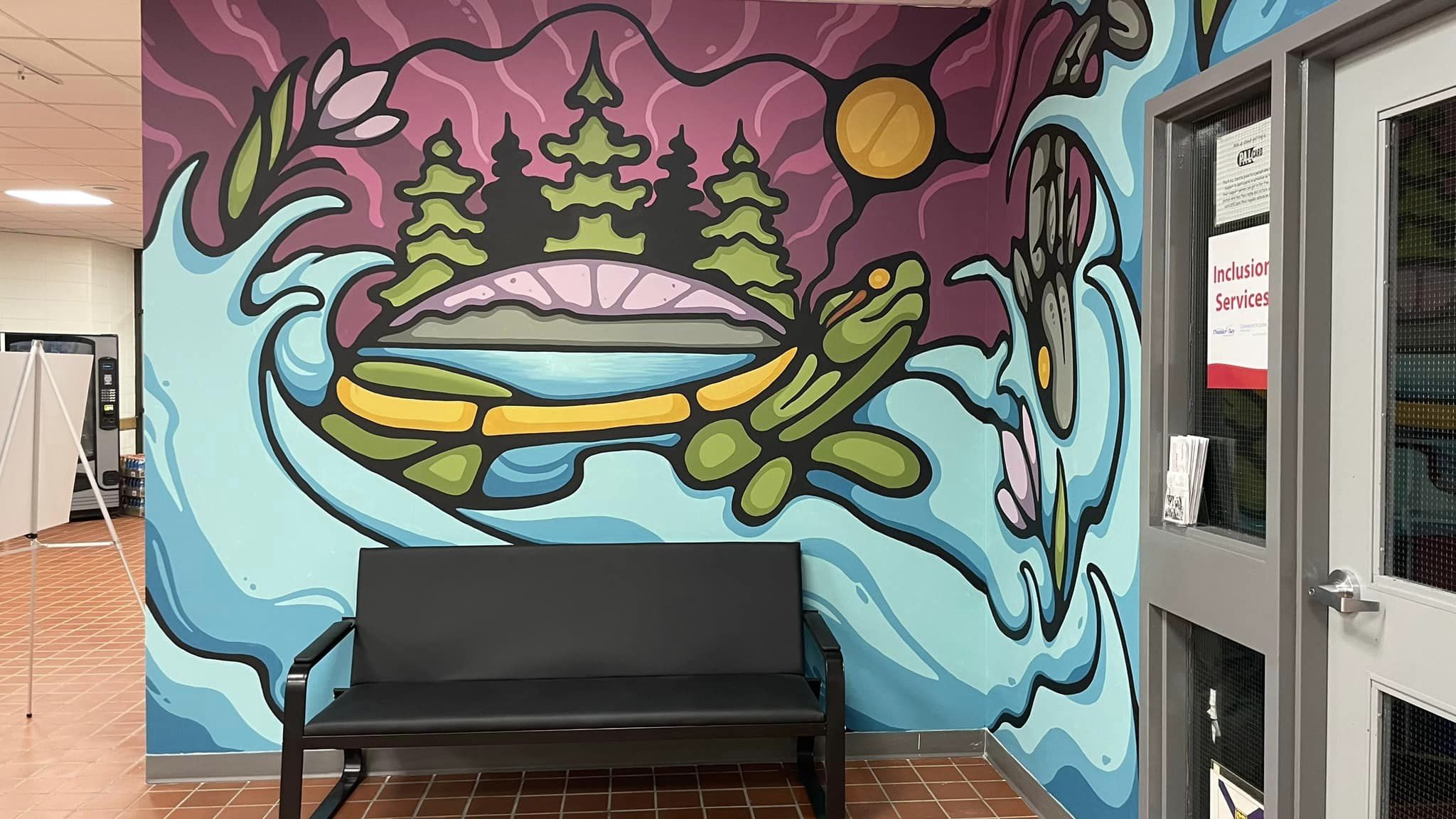 
Ryan, a proud member of the Bear Clan from Fort William First Nation, infuses his Ojibwe heritage into his artistry as both a painter and tattoo artist at Hightide Tattoo Parlour in Thunder Bay, Ontario. His creative expressions draw inspiration from traditional woodland paintings, ancestral stories, and his unique tattooing style, showcasing a fusion of digital and painted pieces.
One of Ryan's captivating pieces, "Turtle Island," intricately weaves the symbolic tale of a turtle carrying the world on its back—a powerful narrative rooted in the Creation Story. According to this story, animals ventured into the depths of the waters to retrieve soil, which was then lovingly placed on the willing turtle's back, birthing what we know as Earth—a poignant representation of creation and home.
The turtle holds profound significance, embodying the essence of life, identity, and the paramount importance of honouring all living beings. "Turtle Island" stands as a testament to unity, urging us to coexist harmoniously with the diverse inhabitants of this shared planet. It serves as a gentle yet potent reminder of our interconnectedness and the obligation we hold to nurture one another, the land, and ourselves. Through its essence, "Turtle Island" champions inclusivity, celebrating diversity and heritage, embracing and cherishing every individual.
In the latter part of Ryan's piece, the spotlight shifts to the imagery of fish—a compelling symbol of collective movement and cooperation. The depiction of fish swimming together in schools serves as a poignant reminder of the inherent value of collective effort and the necessity of harmonious coexistence. |
Growth - boy Roland |
|
2017
Growth, by local artist boy Roland, was selected in 2017 to become the new award distributed to recipients at the annual Thunder Bay Arts & Heritage Awards for two consecutive years of ceremonies. The design features a porcelain hand with a piece of amethyst set in the palm and mounted on a wooden base, representing the continued development and vibrancy of Thunder Bay's cultural sector. "I'm excited to have my design play such a special role in honouring the many deserving award recipients throughout Thunder Bay. Hopefully, my design will serve as a reminder for all the recipients of their achievements far into the future." - boy Roland The design for Growth was selected through open competition administered by the City's Recreation and Culture Division and Public Art Committee. Growth was unveiled at the 7th Annual Thunder Bay Arts & Heritage Awards on February 16, 2017. |
Contact Us


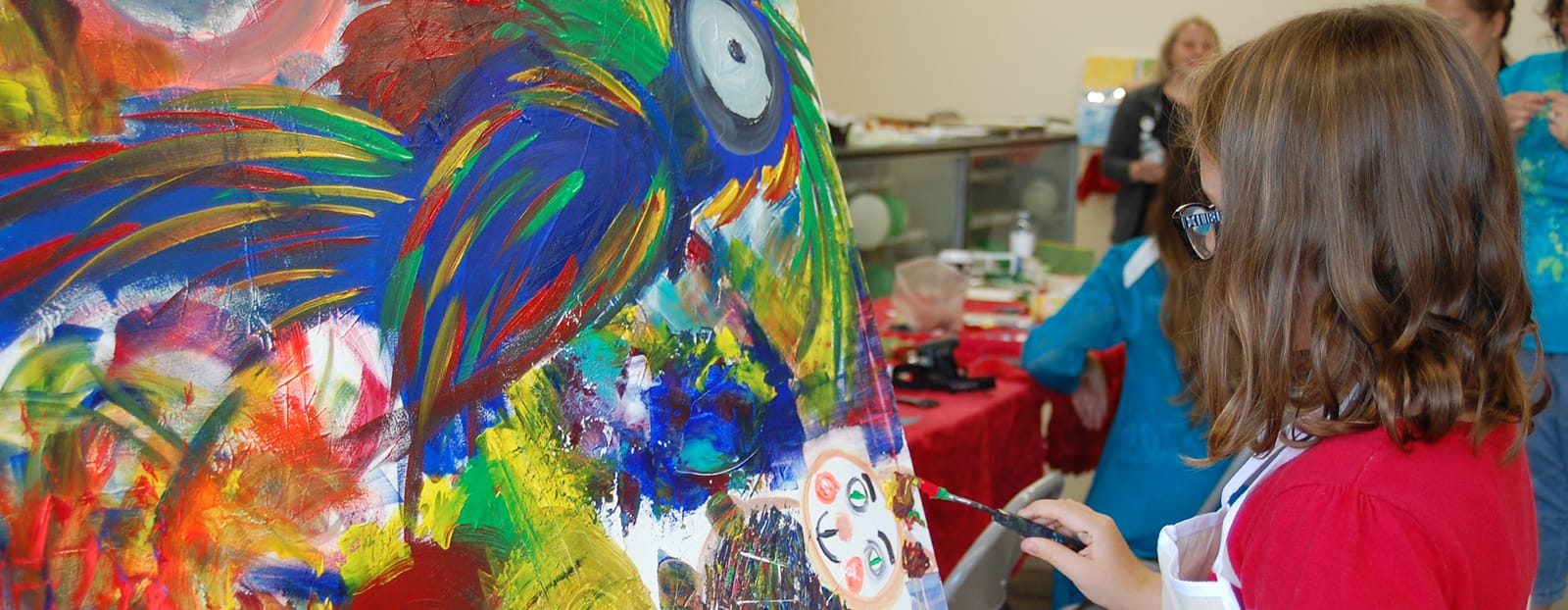







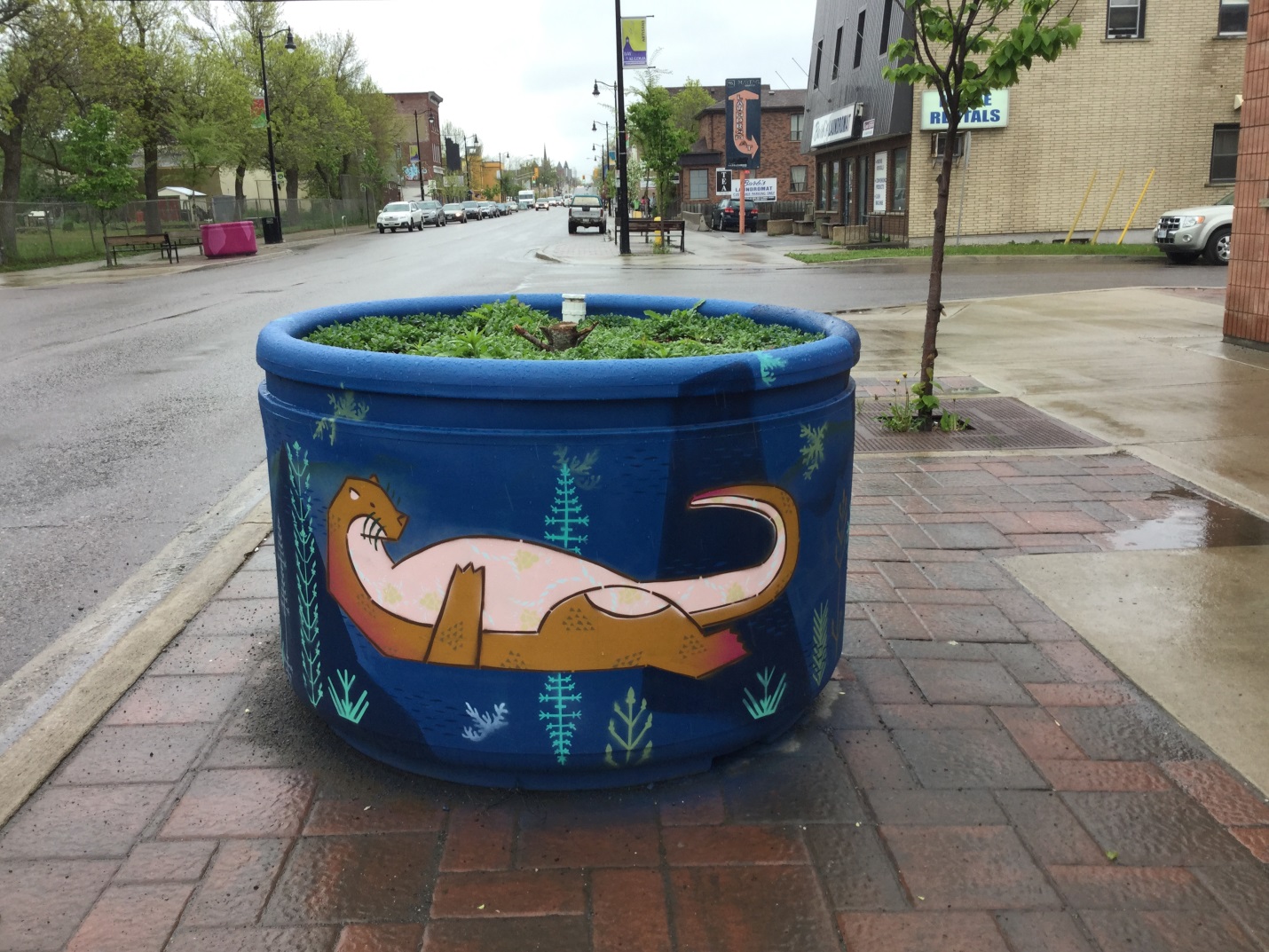
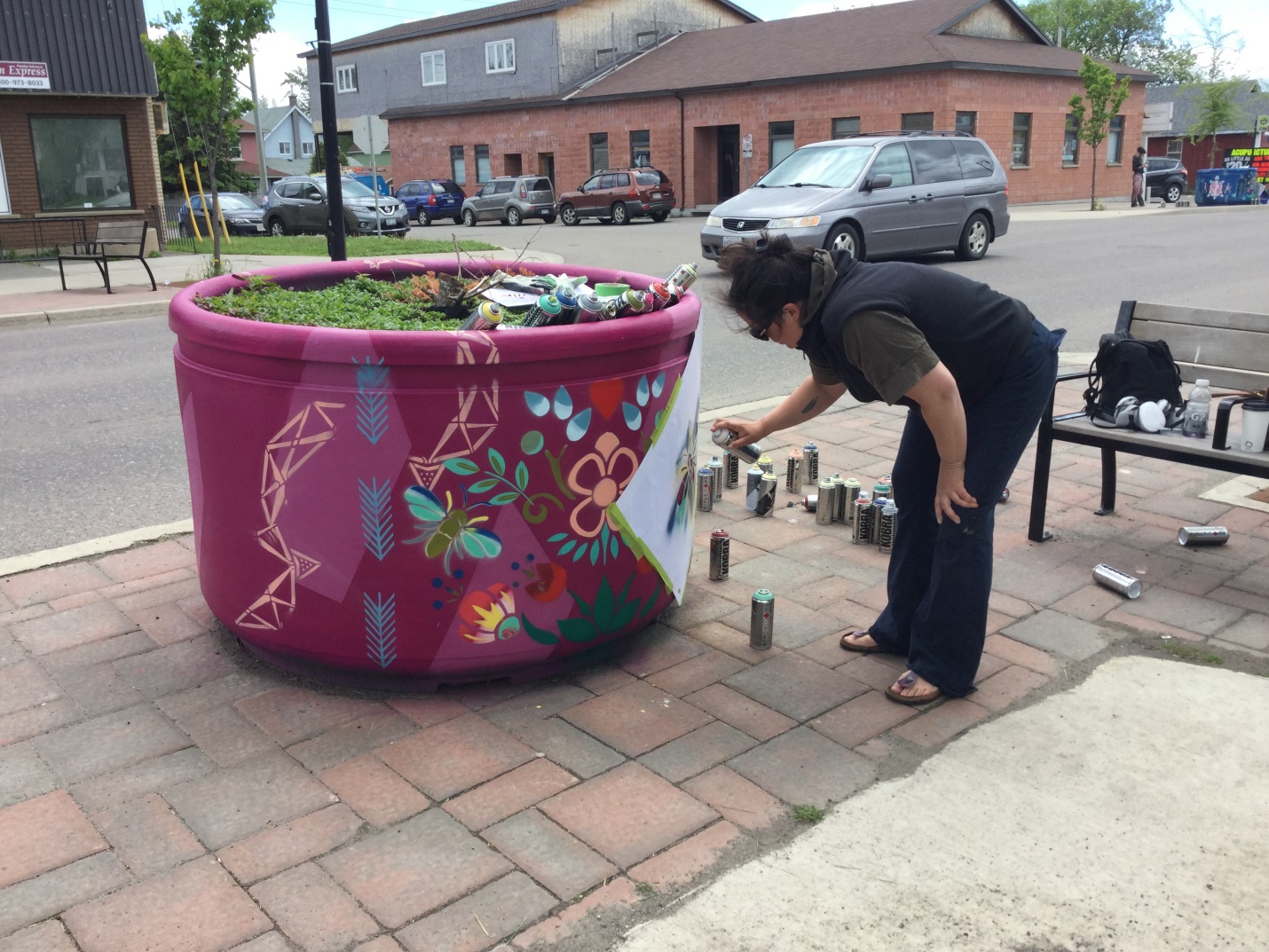
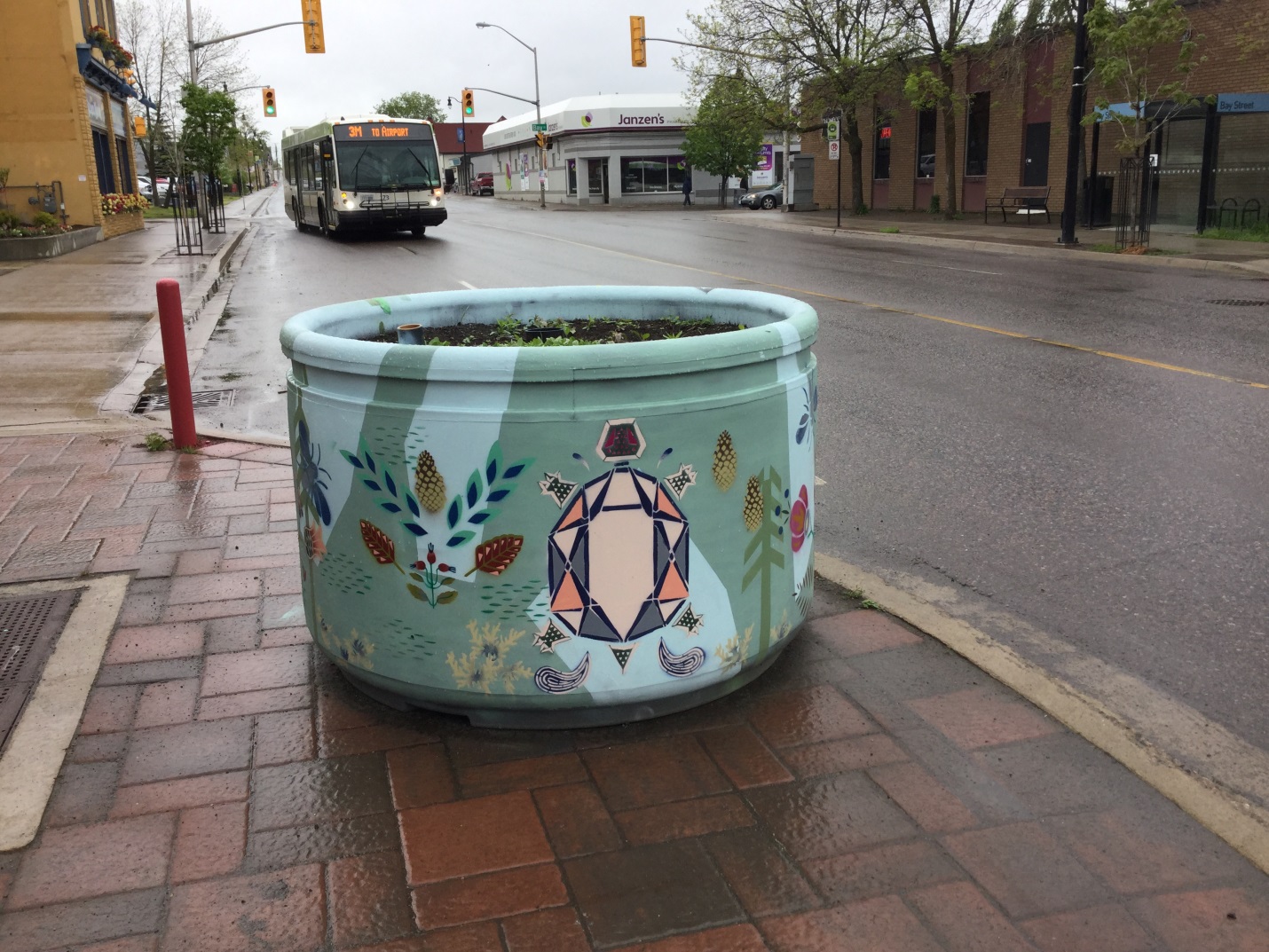
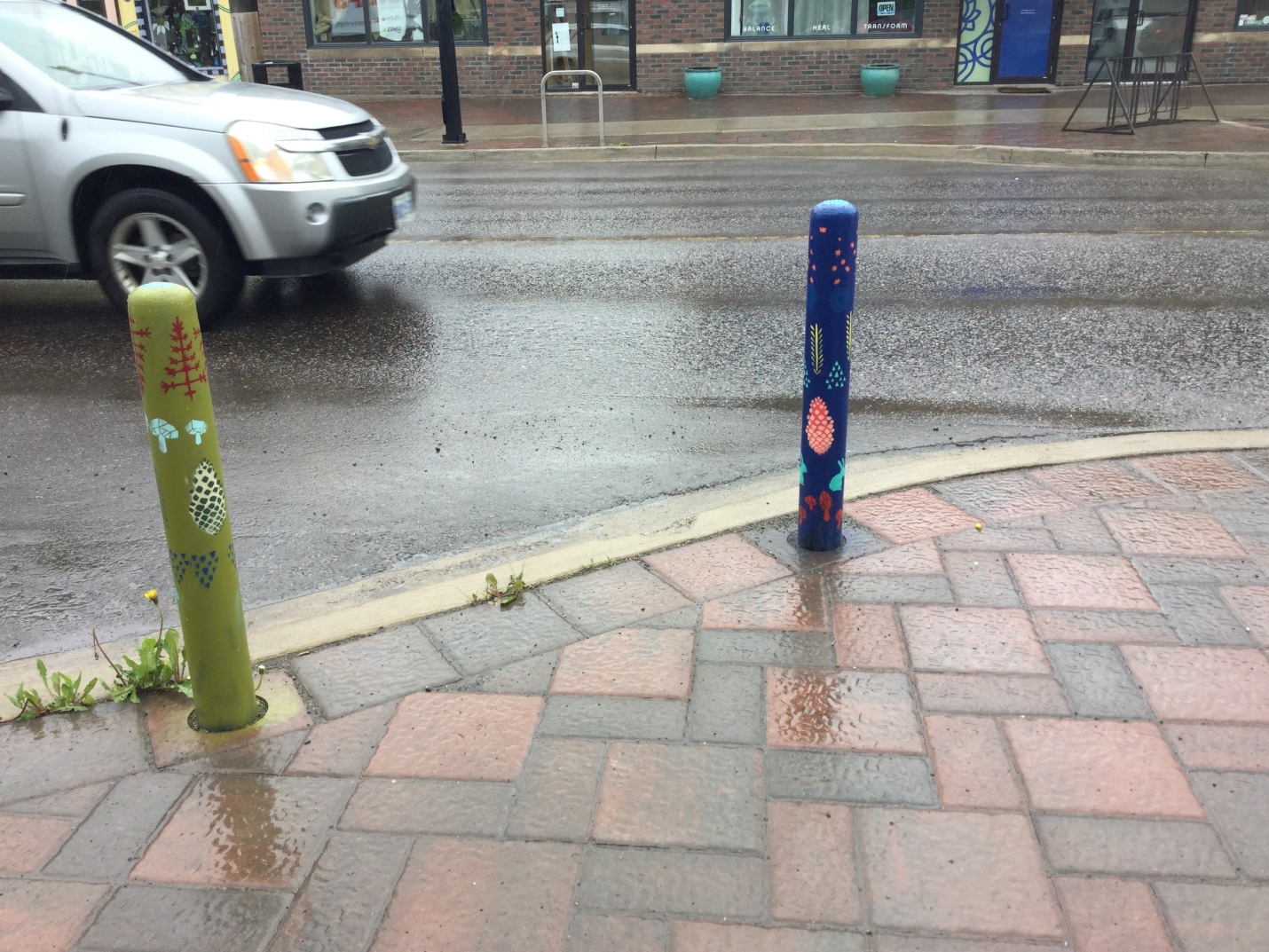

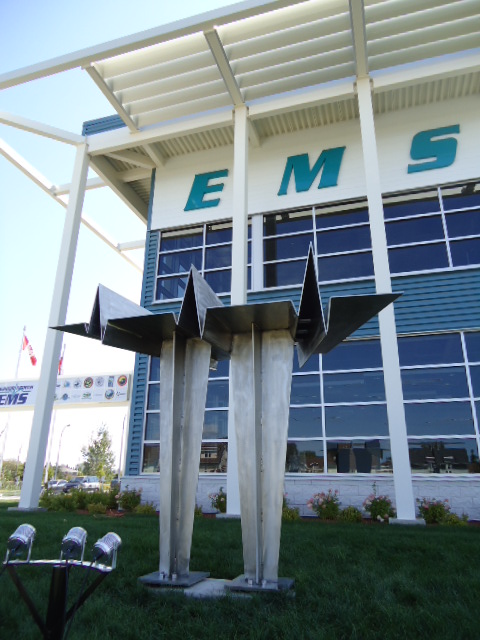
 Fate - Although the imagery stems from Finnish Folklore [Knot of Fate, rope, 12 waves], the symbolism is universal, suggesting that we control our future, each individual brings strength to the community, and we are all inevitably connected. - Caroline Kajorinne
Fate - Although the imagery stems from Finnish Folklore [Knot of Fate, rope, 12 waves], the symbolism is universal, suggesting that we control our future, each individual brings strength to the community, and we are all inevitably connected. - Caroline Kajorinne Pine - Thunder Bay is profoundly connected to trees. Trees have been important to the people of this region for a long time and continue to be today. Pine celebrates our local environment and history; is a symbol of the health of the environment; and is based on the visual splendor of trees. - Luke Nicol
Pine - Thunder Bay is profoundly connected to trees. Trees have been important to the people of this region for a long time and continue to be today. Pine celebrates our local environment and history; is a symbol of the health of the environment; and is based on the visual splendor of trees. - Luke Nicol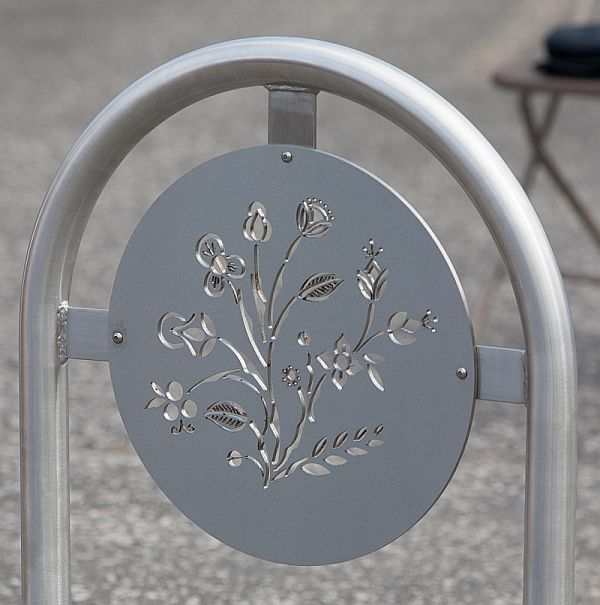 Plantlife - Plantlife is representative of medicine. Our reason for existence is indebted to the land and all it has to offer. Everything is inextricably woven and connected directly to the land. The land and all it provides cannot go unnoticed as a cyclist. - Jean Marshall
Plantlife - Plantlife is representative of medicine. Our reason for existence is indebted to the land and all it has to offer. Everything is inextricably woven and connected directly to the land. The land and all it provides cannot go unnoticed as a cyclist. - Jean Marshall Memory Wheels Turning - The panel design is an interpretation of stories about first time bike rides told by residents of Thunder Bay. The graphic represents a collective history of citizen experiences through the moment of delight, terror, and discovery associated with learning to ride a bicycle. These stories trace the geography of Thunder Bay, the region and places people have come from. - Jennifer Nichols
Memory Wheels Turning - The panel design is an interpretation of stories about first time bike rides told by residents of Thunder Bay. The graphic represents a collective history of citizen experiences through the moment of delight, terror, and discovery associated with learning to ride a bicycle. These stories trace the geography of Thunder Bay, the region and places people have come from. - Jennifer Nichols